Bursa, Turkey, Friday 25 June 2021
Four million Syrian refugees in the country and frankly after ten years many of these are in Turkey to stay.
The reason being that the European Union doesn’t want them.
Thus, the European Union’s move to extend its support to the Syrian refugees in Turkey is an overt message that the bloc will continue to back the efforts of the Turkish people in dealing with around four million refugees on their land, the European envoy to Turkey has said, reiterating that the new financial package will be implemenited in coordination with the Turkish government.

“The European assistance needs to support efforts made by the Turkish municipalities and by the Turkish people.
So, in this sense, I think that the Turkish authorities see the same developments, and we need to live up to them.
So, we want to support them in their effort.”, EU Ambassador to Turkey Nikolaus Meyer-Landrut told the Hürriyet Daily News in an interview on 23 June while paying a visit to Bursa in northwestern Anatolia.

The Ambassador’s remarks came as the EU Council was scheduled to discuss a proposal tabled by EU Commission President Ursula von der Leyen for a new financial package to the countries hosting Syrian refugees, namely Turkey, Jordan, Lebanon and Syria.

Reuters suggested that €3 billion would be allocated to Turkey out of a €5.77 billion package.
Meyer-Landrut did not speculate over the amount of money to be pledged to Turkey but said the size of the package would be adequate to the tasks in regards to hosting four million Syrians who have been living in Turkey for up to ten years.

The situation has changed since Turkey and the EU compromised over the migrant deal in 2016.
Education, professional training and socio-economic development of these communities have become much more important, the Ambassador stressed, informing that the financial assistance would be used in coordination with the Turkish government.

“This is not a European program independent of what Turkish authorities want to achieve.
The implementation of these programs is and will remain in close coordination, of course, with the Turkish authorities.”, he stated.

The 2016 migrant deal was comprehensive and contained a road map for Turkey-EU’s political relationship, highlighting modernization of visa liberalization as an area of cooperation.
None of these goals have come to fruition, although the two sides continue to work on them.
“The statement from 2016 remains valid.”, he said, stressing that visa liberalization is on the agenda.

Istanbul, Turkey, Friday 26 June 2021
In essence, an old problem has not found a new solution, so old patterns are maintained in favour of a familiar status quo.
The future seems nothing more than a reflection of the past while the hopes for tomorrow of a generation of displaced peoples remains uncertain.
I have spent the past week here in Istanbul showing my wife, from whom I have lived apart from since 1 March, this Turkish city of 17 million inhabitants on the Sea of Marmora, where the borders of Asia and Europe kiss, the only metropolis in the world that straddles two continents, this world capital of contradictions.
Where the potential of tomorrow is burdened by the problems of the past and the turmoil of today.
Istanbul’s 2,600-year-old history spans the rise and fall of many empires and occupants, from the ancient Romans to the contemporary Turks.
Today its culture is a reflection of its multifarious past – a mosaic of religions and philosophical paradoxes.

The sights of Hagia Sophia, the Blue Mosque, the Chora Church, the Grand Bazaar, historical Turkish baths, innumerable seafood restaurants, and young pulsating fashionable districts attract millions of visitors to Istanbul every year.


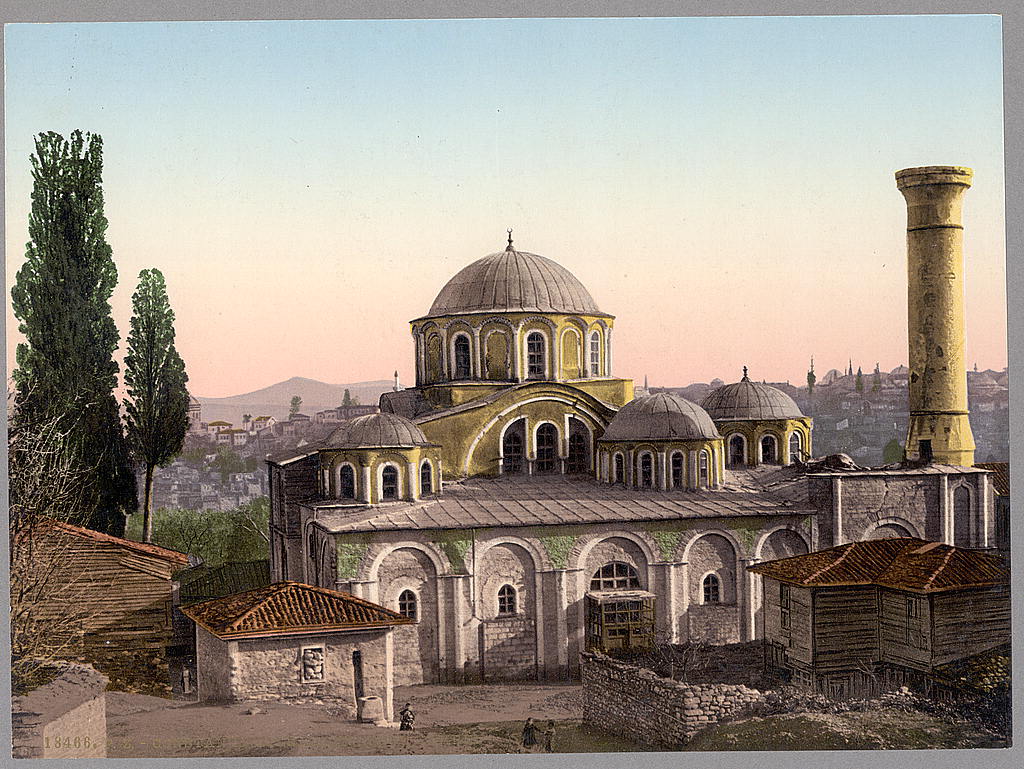


Here one can find a chimerical fusion of a medieval church and a mosque, a Wednesday marketplace that has been here since the Byzantine era, a grand hotel where wealthy guests once rested from their travels on the Orient Express, the place where James Bond foiled an atomic attack, a new mosque which has been built for over 30,000 worshippers, a club where Turkish jazz is played, a bank that laundered Nazi gold, a little park that remains the symbol of protest, a horse’s tomb that became a place of pilgrimage, a tree supported by a pillar in the garden of a Sufi convent that would herald the end of the world if the tree ever fell, a carpet that predicted the death of the Father of Turkey (Mustafa Kemal Atatürk), fragments from the Black Stone of Mecca and hair from the beard of the Prophet.
The list is long.
The old and the new, serenity and serendipity, sorrow and sanctuary.







Above: The Karacaahmet Cemetery (home to the horse tomb)


What is the future of a city, of a country, so caught up in the past, so fearful of the future tarnishing its traditions?
If there is hope for Turkey’s tomorrow it lies in the streets of Istanbul.
It is here that the world gravitates to the crucible of civilizations.

It is here that I am reminded of research done back in February, back in Switzerland, back to Landschlacht where the wife returns tomorrow….

Landschlacht, Switzerland, Saturday 20 February 2021
The headlines speak of a day of death.
At least 130 Russian airstrikes killed 21 members of the Islamic State of Iraq and the Levant (ISIL) in the past 24 hours in the Badia Desert, according to the opposition Syrian Observatory for Human Rights.

Two people were killed and 40 others injured in a clash between police and demonstrators in Mandalay, Myanmar, as the police fired live ammunition to suppress protesters and force workers back to their jobs.

US President Joe Biden declared a major disaster in Texas following a severe winter storm and cold weather that left at least 70 people dead and millions of others without power.
The declaration allows federal funds to be spent and made available to affected people.

Three people were killed, including the gunman, and two others were wounded during a shooting at a gun store and indoor shooting range in Metairie, Louisiana.

Lawlessness and disorder reigned.
The US Department of Justice and the FBI announced that they were investigating whether Alex Jones, Roger Stone and Stop the Steal organizer Ali Alexander played any role in inciting the 6 January riot at the US Capitol.





Looting, barricades and riots were reported during the fifth consecutive night of protests in Barcelona, Spain, over the imprisonment of rapper Pablo Hasél.

Several protesters broke windows at the UNESCO World Heritage Site of Palau de la Música Catalana and also attempted to storm the Stock Exchange of Barcelona.


The Moscow City Court upheld the three-year prison sentence against opposition politician and anti-corruption activist Alexei Navalny.

Navalny also faced slander charges.

His defense had previously said that the European Court of Human Rights had labelled his arrest as “unlawful“.

Thailand’s Prime Minister Prayuth Chan-o-cha survived a second vote of no-confidence in the House of Representatives, accused of mismanagement of the economy, mishandling of the COVID-19 pandemic, corruption and abuse of human rights.

Life in Landschlacht was quiet by comparison.
There was time for reading and reflection.

Today (20 February) is the anniversary of the publication of the Manifesto of Futurism written by the Italian poet Filippo Tommaso Marinetti and published in 1909.

Marinetti expresses an artistic philosophy called Futurism that was a rejection of the past and a celebration of speed, machinery, violence, youth and industry.
It also advocated the modernization and cultural rejuvenation of Italy.
The limits of Italian literature at the end of the Ottocento (19th century), its lack of strong contents, its quiet and passive laissez-faire, are fought by futurists (Articles 1, 2 and 3) and their reaction includes the use of excesses intended to prove the existence of a dynamic surviving Italian intellectual class.

In this period in which industry is of growing importance in all Europe, futurists need to confirm that Italy is present, has an industry, has the power to take part in the new experience and will find the superior essence of progress in its major symbols like the car and its speed (Article 4).

Nationalism is never openly declared, but it is evident.
Futurists insist that literature will not be overtaken by progress, rather it will absorb progress in its evolution and will demonstrate that such progress must manifest in this manner because man will use this progress to sincerely let his instinctive nature explode.
Man is reacting against the potentially overwhelming strength of progress and shouts out his centrality.
Man will use speed, not the opposite (Articles 5 and 6).

Poetry will help man to consent his soul be part of all that (Articles 6 and 7), indicating a new concept of beauty that will refer to the human instinct of aggression.

The sense of history cannot be neglected as this is a special moment, many things are going to change into new forms and new contents, but man will be able to pass through these variations (Article 8), bringing with himself what comes from the beginning of civilization.

In Article 9, war is defined as a necessity for the health of human spirit, a purification that allows and benefits idealism.
Their explicit glorification of war and its “hygienic” properties influenced the ideology of fascism.

Marinetti was very active in fascist politics until he withdrew in protest of the “Roman Grandeur” which had come to dominate fascist aesthetics.
Article 10 states:
“We want to demolish museums and libraries, fight morality, feminism and all opportunist and utilitarian cowardice.”

This manifesto was published well before the occurrence of any of the 20th-century events which are commonly suggested as a potential meaning of this text.
Many of them could not even be imagined yet.
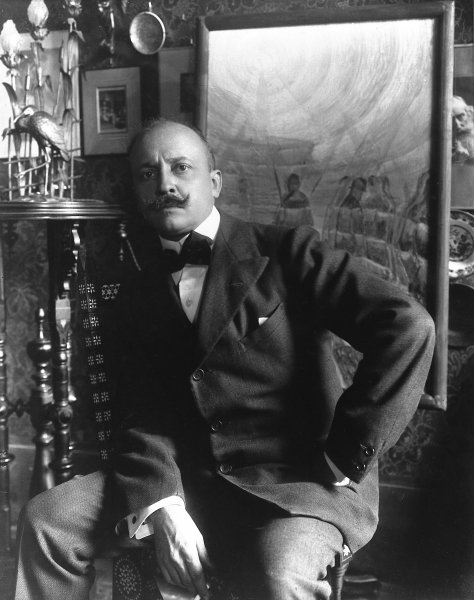
For example, the Russian Revolutions of 1917 were the first successfully maintained revolution of the sort described by Article 11.
The series of smaller scale peasant uprisings that had been known as the Russian Revolution previous to the occurrences of 1917 took place in the years immediately before the Manifesto’s publication and instigated the State Duma’s creation of a Russian constitution in 1906.

The effect of the Manifesto is even more evident in the Italian version.
Not one of the words used is casual.
If not the precise form, at least the roots of these words recall those more frequently used during the Middle Ages, particularly during the Rinascimento (the Italian Renaissance)..
The founding manifesto did not contain a positive artistic programme, which the Futurists attempted to create in their subsequent Technical Manifesto of Futurist Painting (1914).
This committed them to a “universal dynamism“, which was to be directly represented in painting.

Objects in reality were not separate from one another or from their surroundings:
“The sixteen people around you in a rolling motor bus are in turn and at the same time one, ten four three.
They are motionless and they change places.
The motor bus rushes into the houses which it passes, and in their turn the houses throw themselves upon the motor bus and are blended with it.”

Futurism (Italian: Futurismo) was an artistic and social movement that originated in Italy in the early 20th century.
It emphasized dynamism, speed, technology, youth, violence, and objects such as the car, the airplane, and the industrial city.
Its key figures were the Italians Filippo Tommaso Marinetti, Umberto Boccioni, Carlo Carrã, Fortunato Depero, Gino Severini, Giacomo Balla and Luigi Russolo.






It glorified modernity and aimed to liberate Italy from the weight of its past.
Important Futurist works included Marinetti’s Manifesto of Futurism, Boccioni’s sculpture Unique Forms of Continuity in Space, Balla’s painting Abstract Speed and Sound, and Russolo’s The Art of Noises.



Although it was largely an Italian phenomenon, there were parallel movements in Russia, where some Russian Futurists would later go on to found groups of their own.
Other countries either had a few Futurists or had movements inspired by Futurism.

The Futurists practiced in every medium of art, including painting, sculpture, ceramics, graphic design, industrial design, interior design, urban design, theatre, film, fashion, textiles, literature, music, architecture, and even cooking.
To some extent Futurism influenced the art movements Art Deco, Constructivism, Surrealism and Dada, and to a greater degree Precisionism, Rayonism and Vorticism.



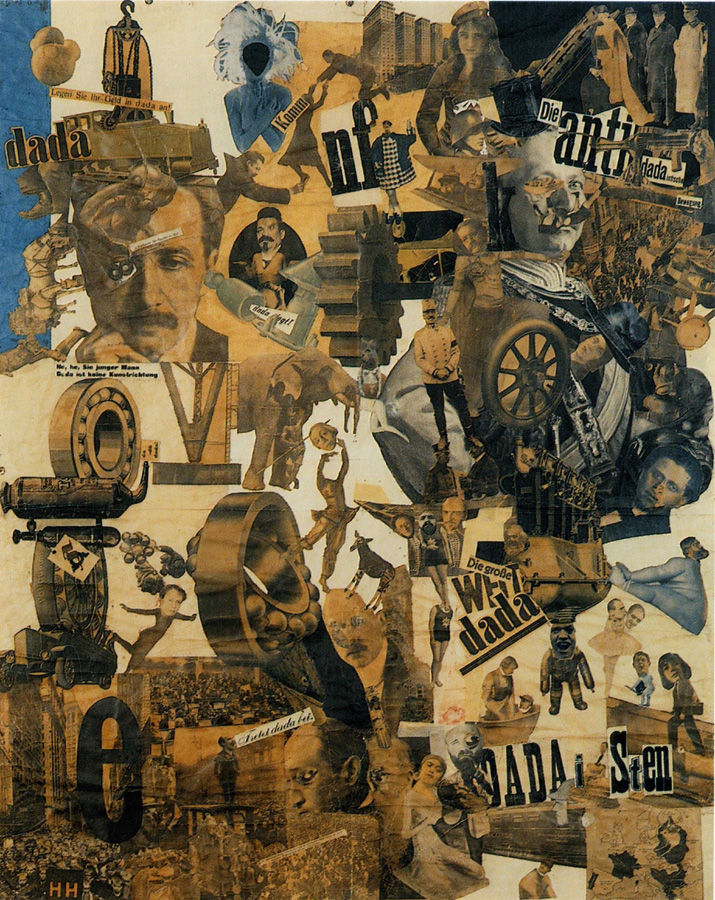



Marinetti expressed a passionate loathing of everything old, especially political and artistic tradition.
“We want no part of it, the past“, he wrote, “we the young and strong Futurists!”
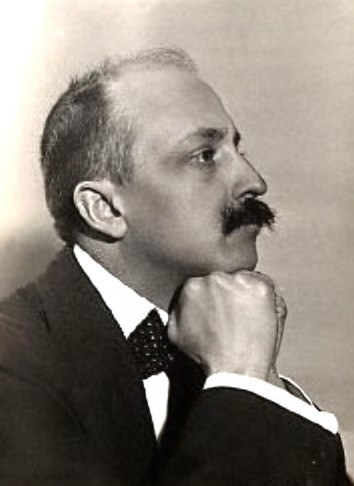
The Futurists admired speed, technology, youth and violence, the car, the airplane and the industrial city, all that represented the technological triumph of humanity over nature.
They were passionate nationalists.
They repudiated the cult of the past and all imitation, praised originality, “however daring, however violent“, bore proudly “the smear of madness“, dismissed art critics as useless, rebelled against harmony and good taste, swept away all the themes and subjects of all previous art, and gloried in science.
Publishing manifestos was a feature of Futurism, and the Futurists (usually led or prompted by Marinetti) wrote them on many topics, including painting, architecture, music, literature, photography, religion, women, fashion and cuisine.
They often painted modern urban scenes.
Carrà’s Funeral of the Anarchist Galli (1911) is a large canvas representing events that the artist had himself been involved in, in 1904.
The action of a police attack and riot is rendered energetically with diagonals and broken planes.
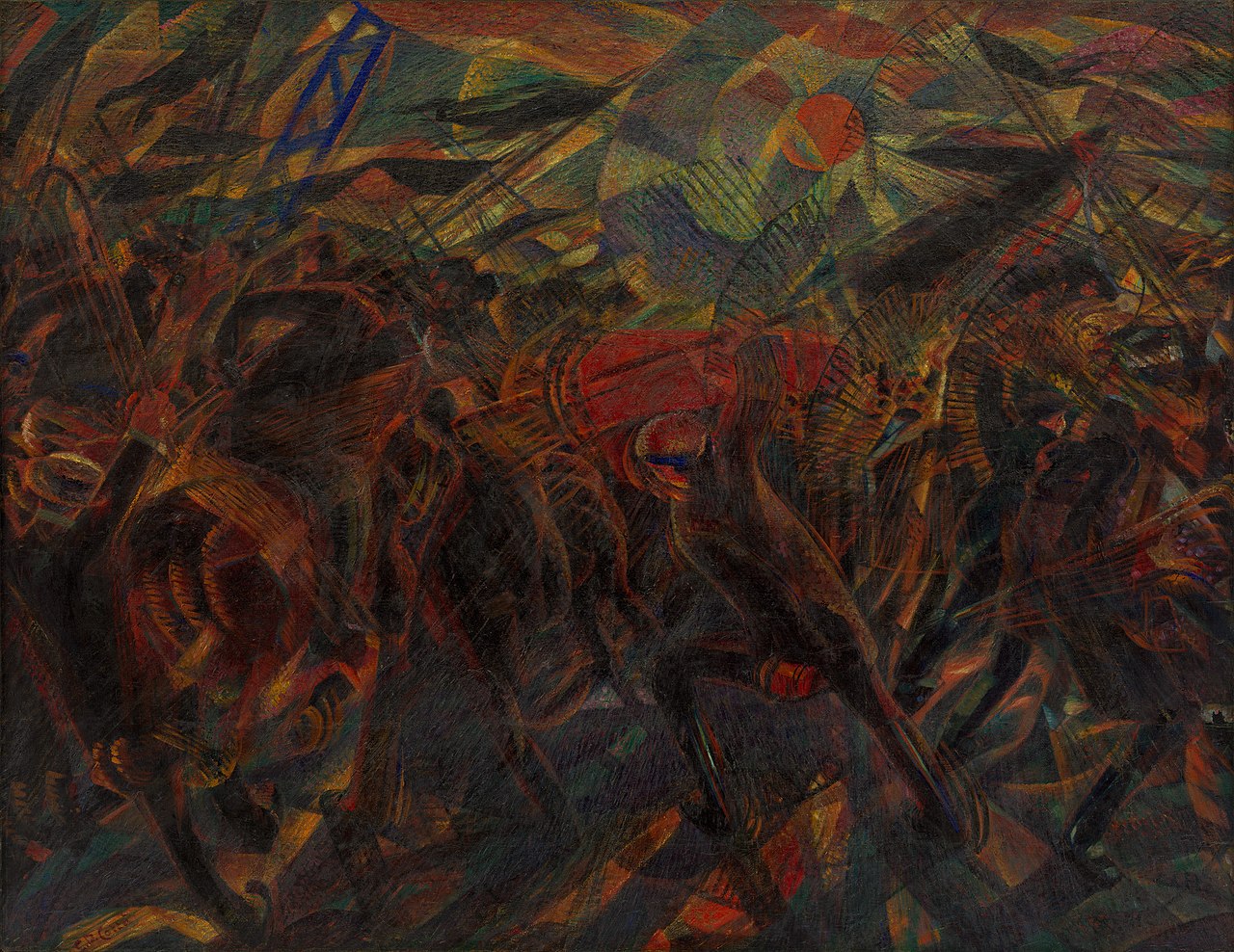
His Leaving the Theatre (1911) uses a Divisionist technique to render isolated and faceless figures trudging home at night under street lights.
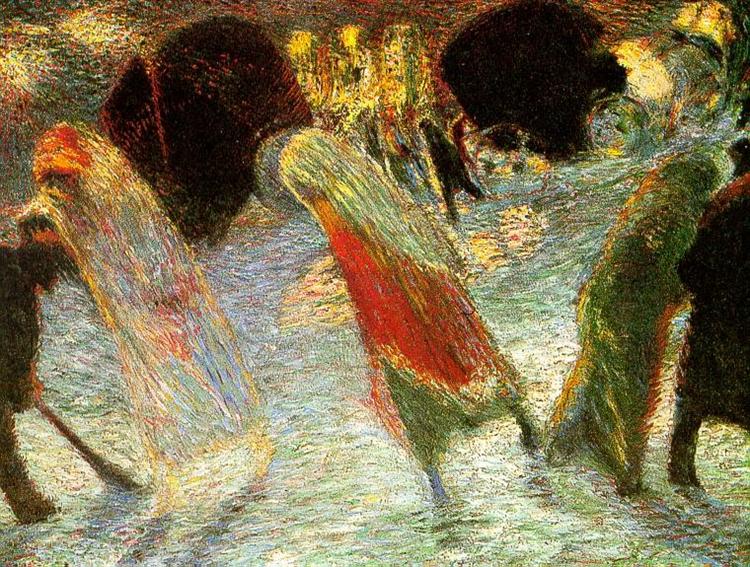
Above: Carlo Carrã, Leaving the Theatre (1911)
Boccioni’s The City Rises (1910) represents scenes of construction and manual labour with a huge, rearing red horse in the centre foreground, which workmen struggle to control.
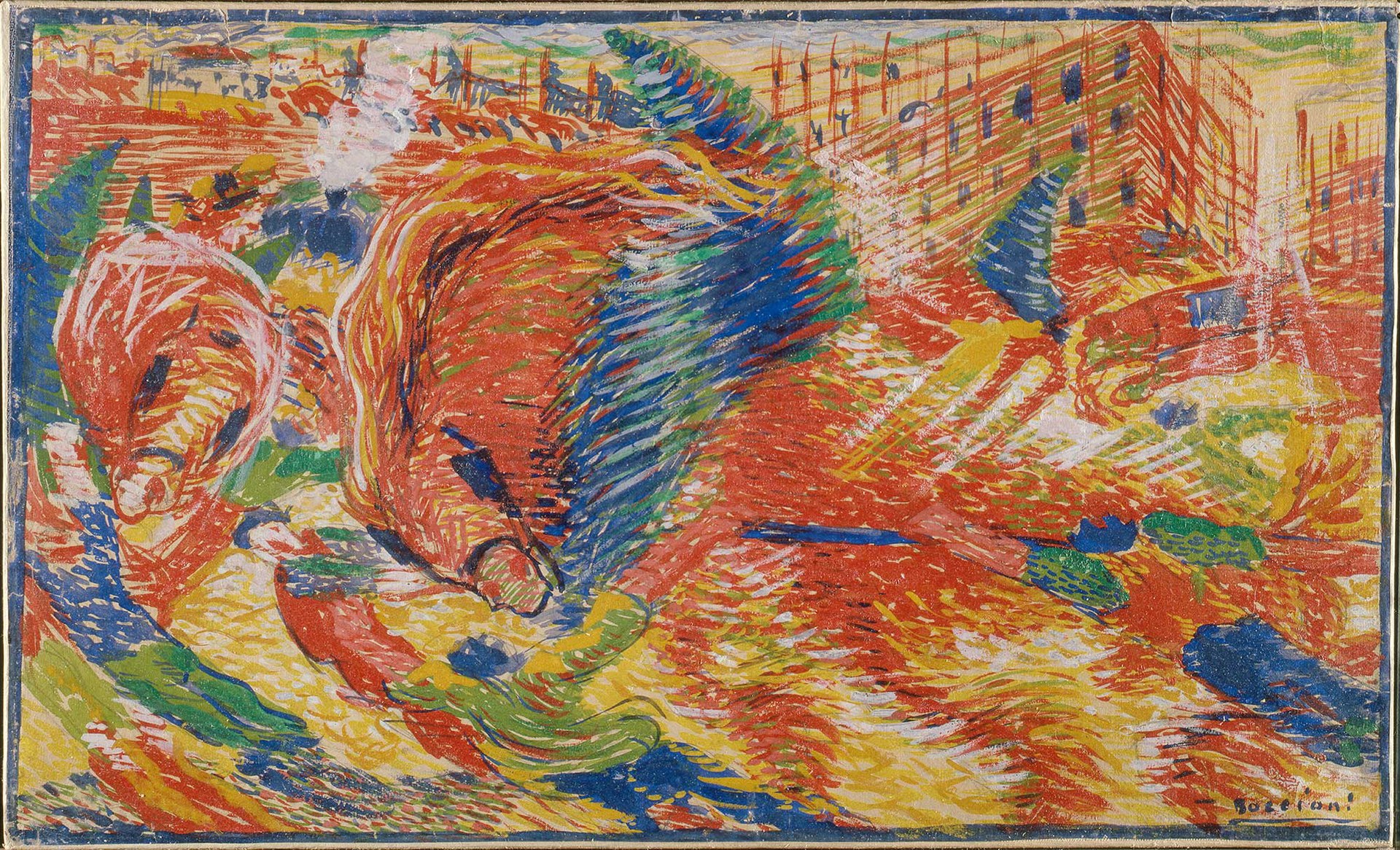
His States of Mind, in three large panels, The Farewells, Those who Go, and Those Who Stay, “made his first great statement of Futurist painting, bringing his interests in Bergson, Cubism and the individual’s complex experience of the modern world together in what has been described as one of the ‘minor masterpieces’ of early 20th century painting.”
The work attempts to convey feelings and sensations experienced in time, using new means of expression, including “lines of force“, which were intended to convey the directional tendencies of objects through space, “simultaneity“, which combined memories, present impressions and anticipation of future events, and “emotional ambience” in which the artist seeks by intuition to link sympathies between the exterior scene and interior emotion.

Boccioni’s intentions in art were strongly influenced by the ideas of Bergson, including the idea of intuition, which French philosopher Henri Bergson defined as a simple, indivisible experience of sympathy through which one is moved into the inner being of an object to grasp what is unique and ineffable within it.
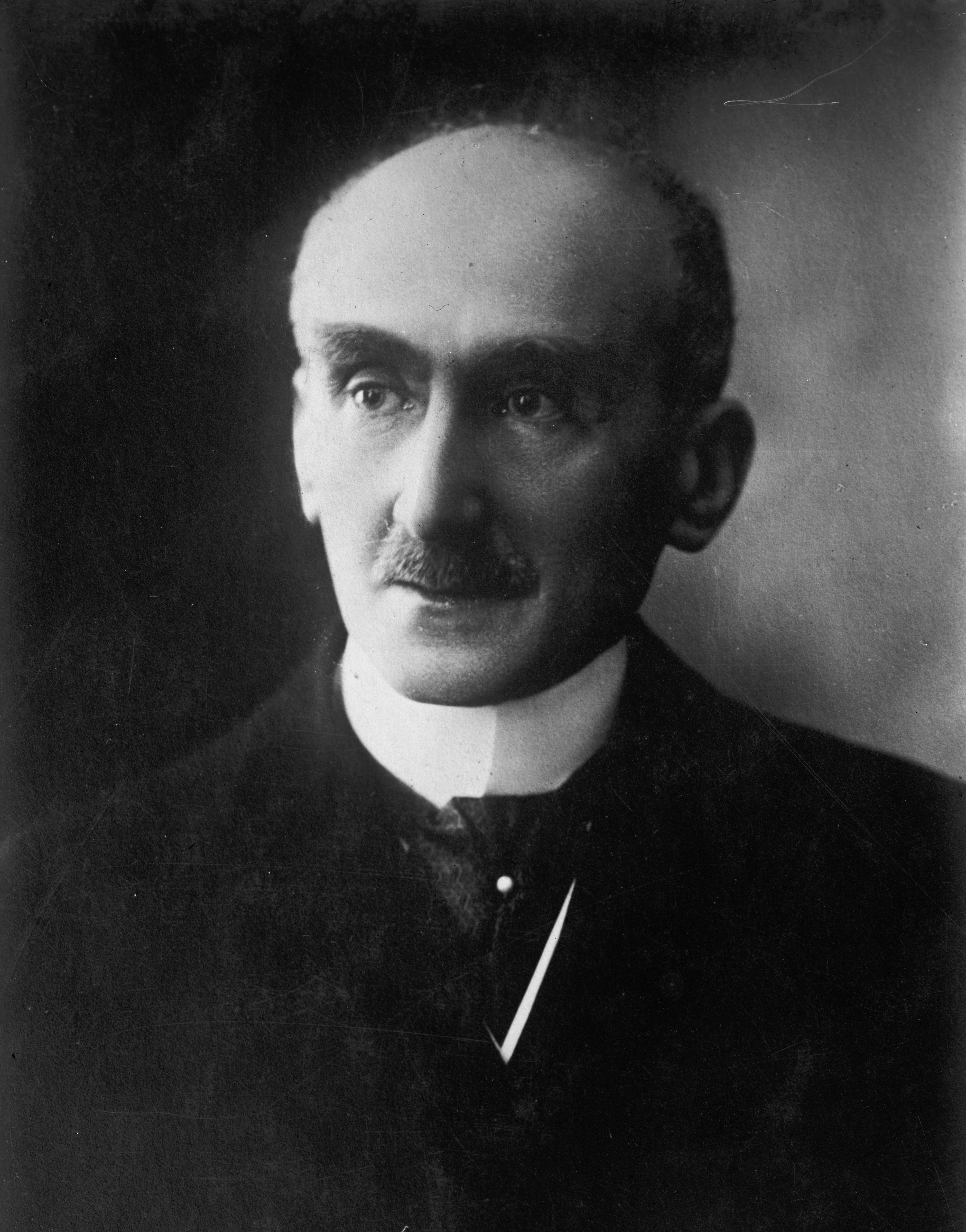
The Futurists aimed through their art thus to enable the viewer to apprehend the inner being of what they depicted.
Balla’s Dynamism of a Dog on a Leash (1912) exemplifies the Futurists’ insistence that the perceived world is in constant movement.
The painting depicts a dog whose legs, tail and leash—and the feet of the woman walking it—have been multiplied to a blur of movement.

It was the urban scene and vehicles in motion that typified Futurist painting: Boccioni’s The Street Enters the House (1911), Severini’s Dynamic Hieroglyph of the Bal Tabarin (1912), and Russolo’s Automobile at Speed (1913).
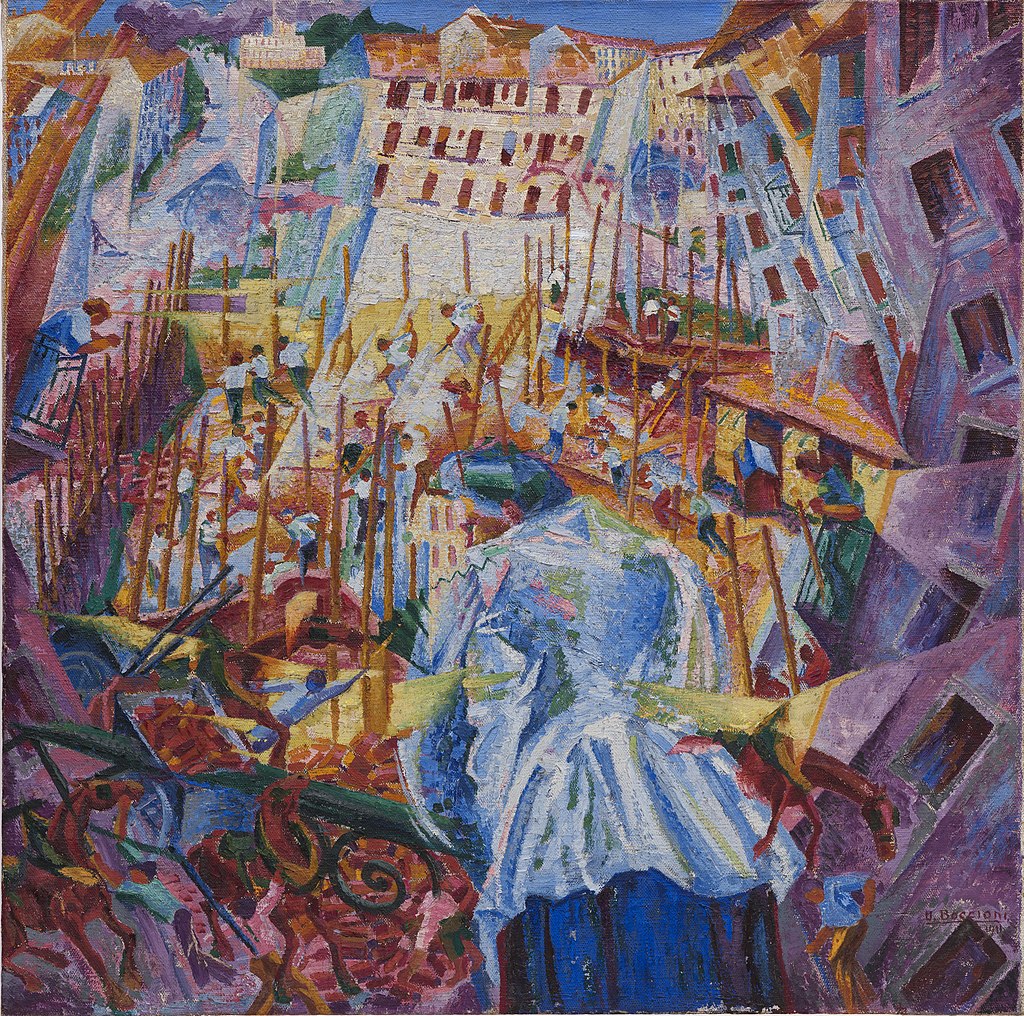

Above: Gino Severini, Dynamic Hieroglyphic of the Bal Tabarin (1912)
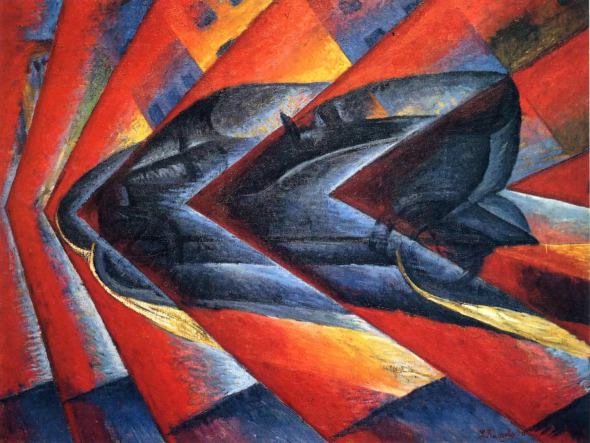
In 1914, personal quarrels and artistic differences between the Milan group, around Marinetti, Boccioni, and Balla, and the Florence group, around Carrà, Ardengo Soffici and Giovanni Papini, created a rift in Italian Futurism.


The Florence group resented the dominance of Marinetti and Boccioni, whom they accused of trying to establish “an immobile church with an infallible creed“, and each group dismissed the other as passéiste.
Futurism had from the outset admired violence and was intensely patriotic.
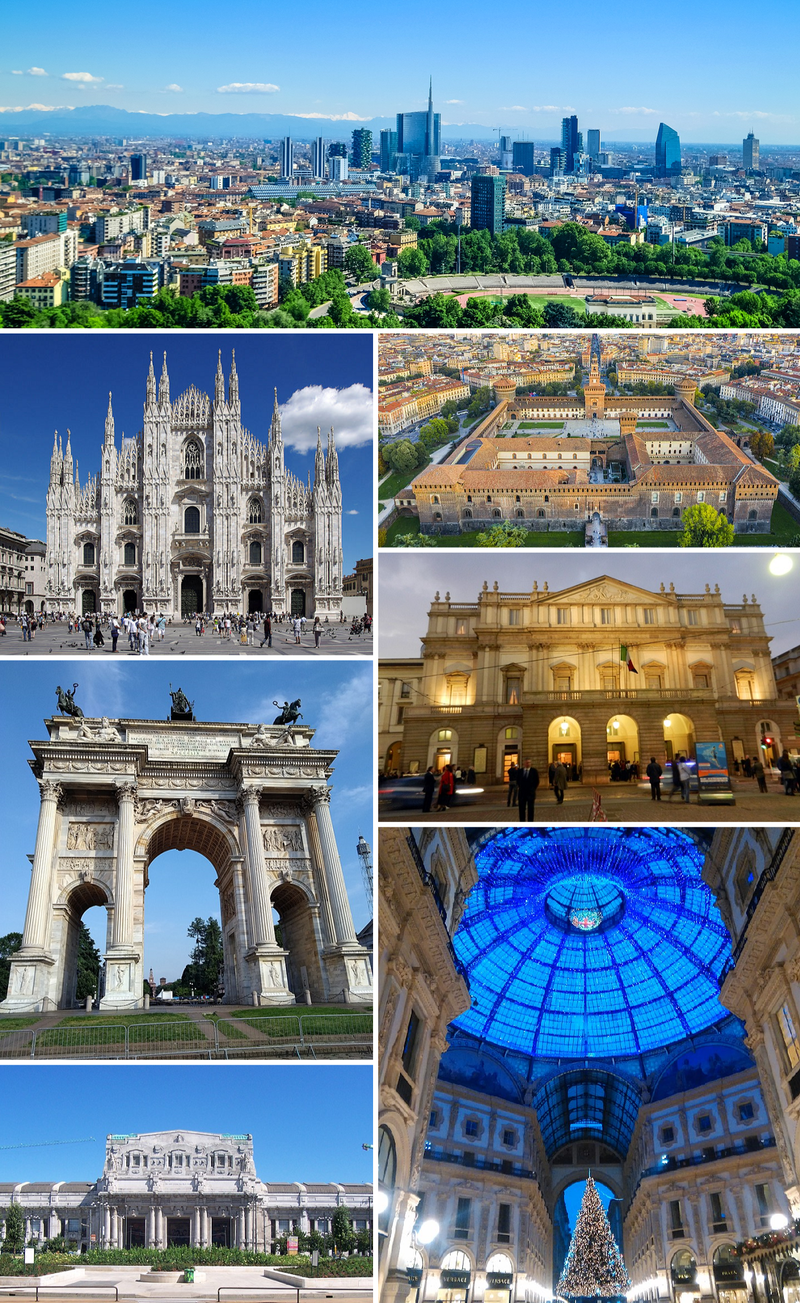

The Futurist Manifesto had declared:
“We will glorify war — the world’s only hygiene — militarism, patriotism, the destructive gesture of freedom-bringers, beautiful ideas worth dying for, and scorn for woman.”

Although it owed much of its character and some of its ideas to radical political movements, futurism was not much involved in politics until the autumn of 1913.
Then, fearing the re-election of Italian Prime Minister Giovanni Giolitti, Marinetti published a political manifesto.


In 1914 the Futurists began to campaign actively against the Austro-Hungarian empire, which still controlled some Italian territories, and Italian neutrality between the major powers.

In September, Boccioni, seated in the balcony of the Teatro dal Verme in Milan, tore up an Austrian flag and threw it into the audience, while Marinetti waved an Italian flag.

When Italy entered the First World War in 1915, many Futurists enlisted.
The experience of the war marked several Futurists, particularly Marinetti, who fought in the mountains of Trentino at the border of Italy and Austria-Hungary, actively engaging in propaganda.

The combat experience also influenced Futurist music.
The outbreak of war disguised the fact that Italian Futurism had come to an end.
The Florence group had formally acknowledged their withdrawal from the movement by the end of 1914.
Boccioni produced only one war picture and was killed in 1916.
Severini painted some significant war pictures in 1915 (e.g. War, Armoured Train, and Red Cross Train), but in Paris turned towards Cubism and post-war was associated with the return to order.
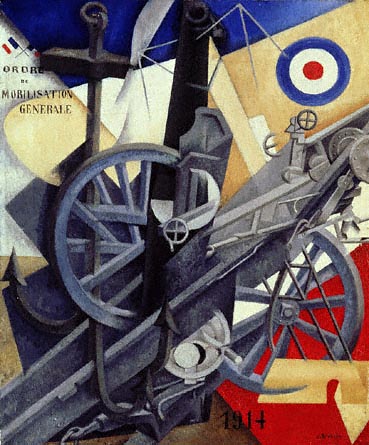
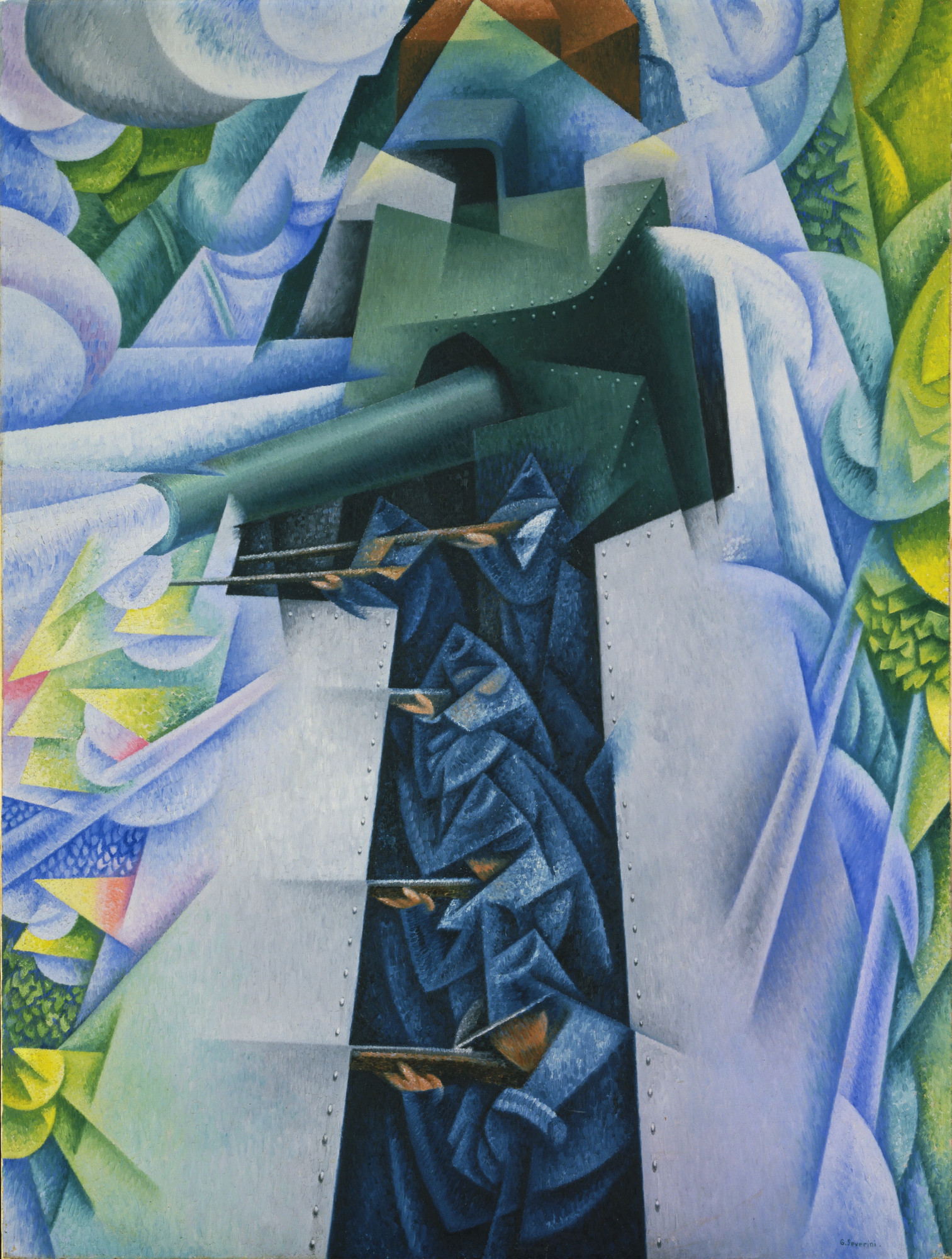
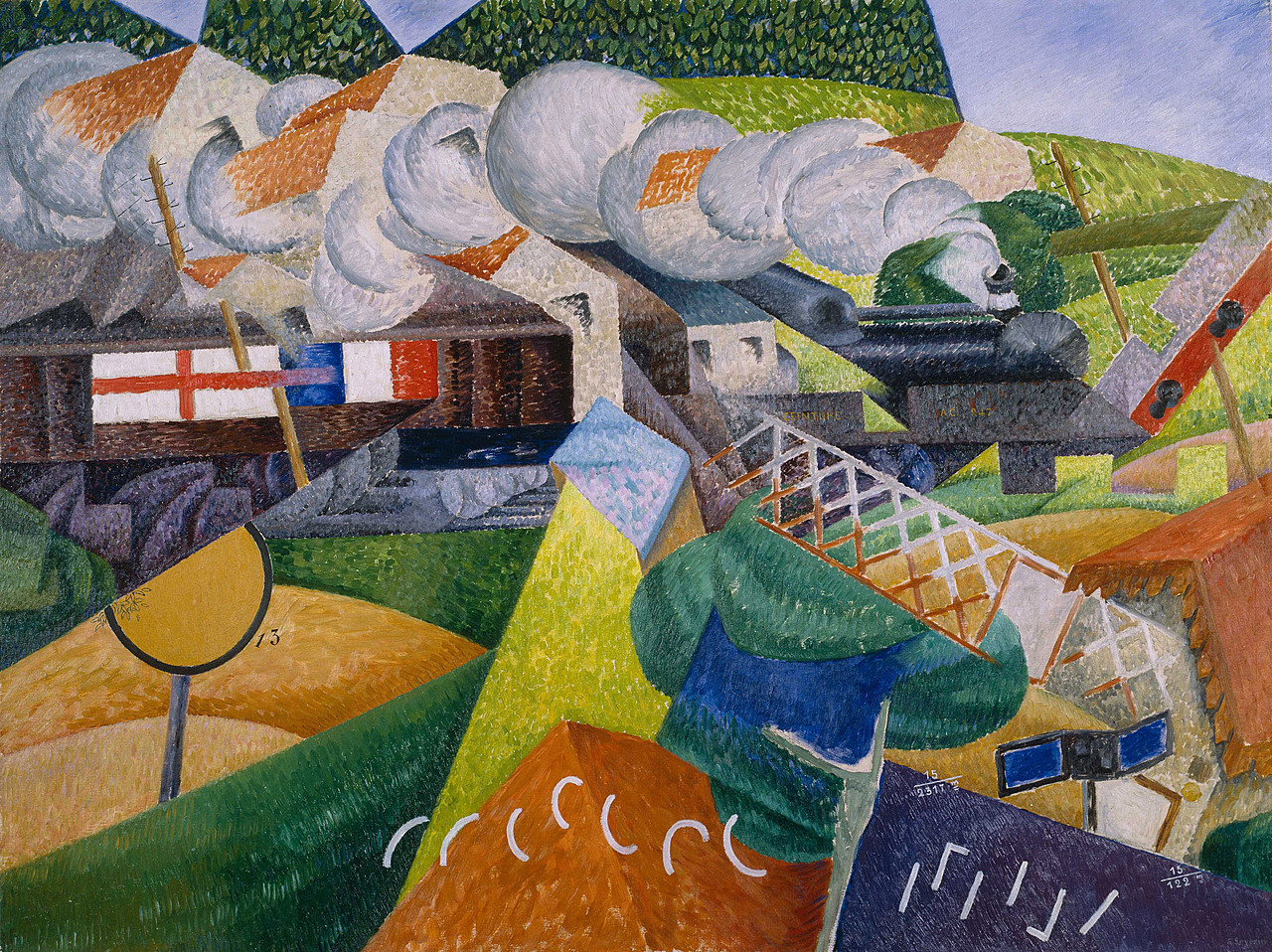
After the war, Marinetti revived the movement.
This revival was called il secondo Futurismo (Second Futurism) by writers in the 1960s.

The art historian Giovanni Lista has classified Futurism by decades: “Plastic Dynamism” for the first decade, “Mechanical Art” for the 1920s, “Aeroaesthetics” for the 1930s.

Russian Futurism was a movement of literature and the visual arts, involving various Futurist groups.
The poet Vladimir Mayakovsky was a prominent member of the movement, as were Velimir Khlebnikov and Aleksei Kruchyonykh.
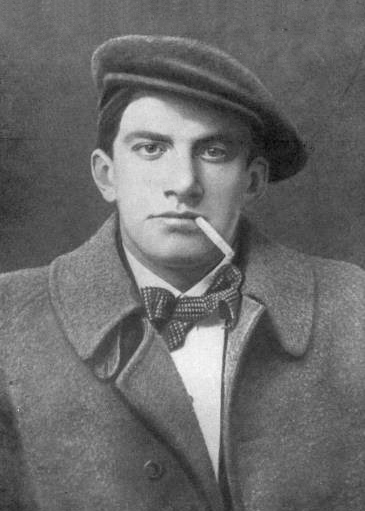
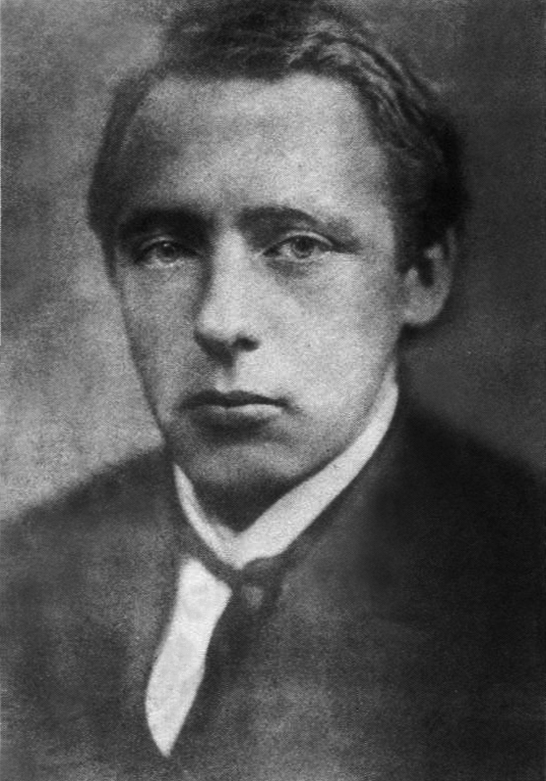

Visual artists such as David Burliuk, Mikhail Larionov, Natalia Goncharova, Lyubov Popova and Kazimir Malevich found inspiration in the imagery of Futurist writings, and were writers themselves.





Poets and painters collaborated on theatre production, such as the Futurist opera Victory Over the Sun, with texts by Kruchenykh, music by Mikhail Matyushin, and sets by Malevich.

The main style of painting was Cubo-Futurism, extant during the 1910s.
Cubo-Futurism combines the forms of Cubism with the Futurist representation of movement; like their Italian contemporaries, the Russian Futurists were fascinated with dynamism, speed and the restlessness of modern urban life.
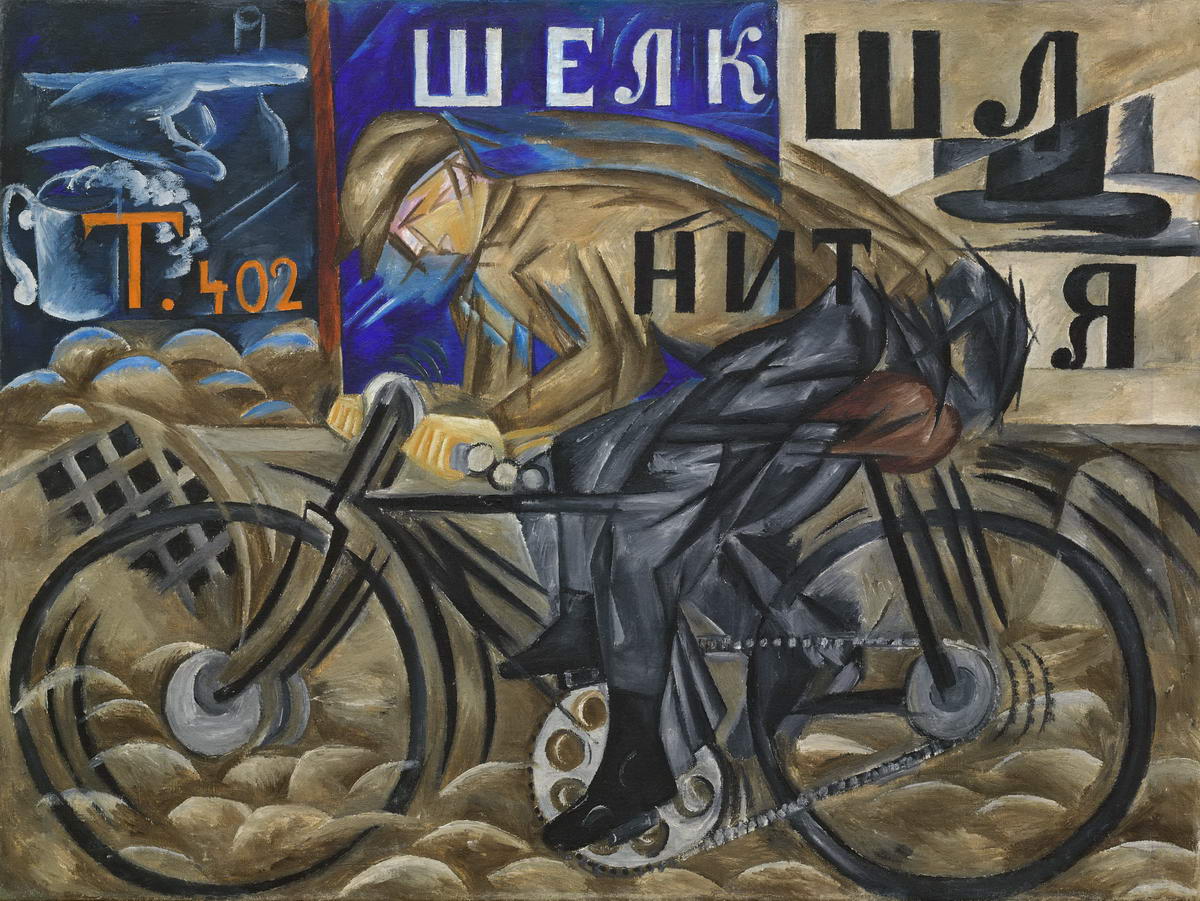
The Russian Futurists sought controversy by repudiating the art of the past, saying that Pushkin and Dostoevsky should be “heaved overboard from the steamship of modernity“.
They acknowledged no authority and professed not to owe anything even to Marinetti, whose principles they had earlier adopted, most of whom obstructed him when he came to Russia to proselytize in 1914.
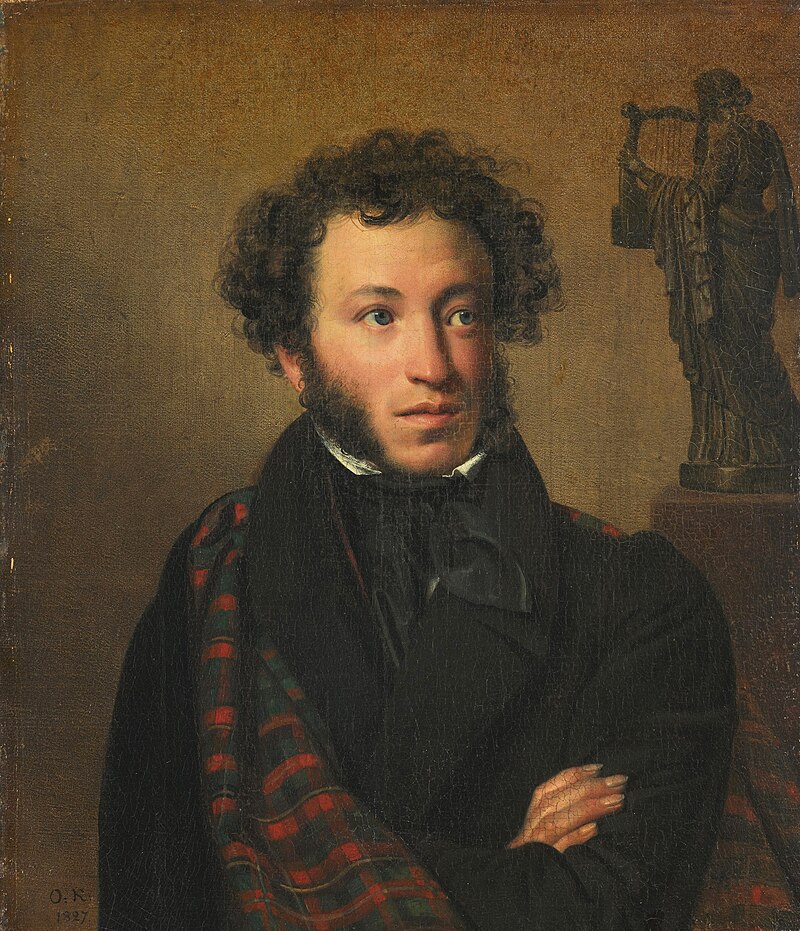
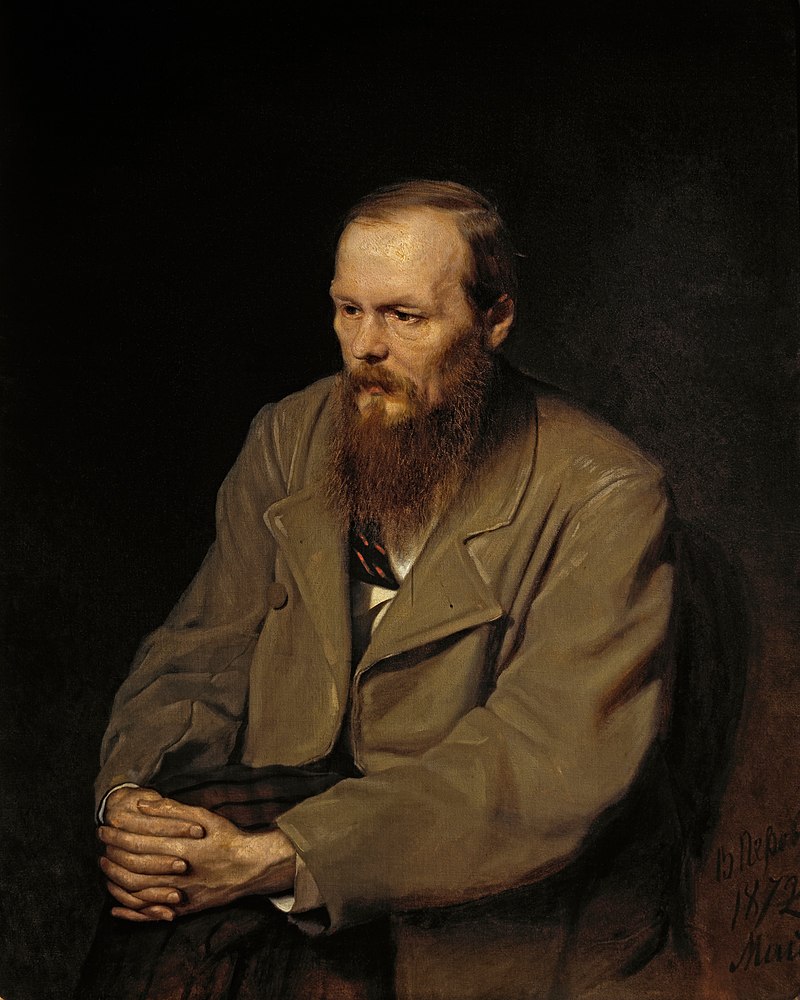
The movement began to decline after the Revolution of 1917.
The Futurists either stayed, were persecuted, or left the country.

Popova, Mayakovsky and Malevich became part of the Soviet establishment and the brief Agitprop movement of the 1920s.
Popova died of a fever, Malevich would be briefly imprisoned and forced to paint in the new state-approved style, and Mayakovsky committed suicide on 14 April 1930.

Futurism as a literary movement made its official debut with F.T. Marinetti’s Manifesto of Futurism (1909), as it delineated the various ideals Futurist poetry should strive for.

Poetry, the predominate medium of Futurist literature, can be characterized by its unexpected combinations of images and hyper-conciseness (not to be confused with the actual length of the poem).
The Futurists called their style of poetry parole in libertà (word autonomy), in which all ideas of meter were rejected and the word became the main unit of concern.
In this way, the Futurists managed to create a new language free of syntax punctuation, and metrics that allowed for free expression.
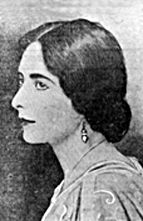
Theater also has an important place within the Futurist universe.
Works in this genre have scenes that are few sentences long, have an emphasis on nonsensical humor, and attempt to discredit the deep rooted traditions via parody and other devaluation techniques.

There are a number of examples of Futurist novels from both the initial period of Futurism and the neo-Futurist period, from Marinetti himself to a number of lesser known Futurists, such as Primo Conti, Ardengo Soffici and Giordano Bruno Sanzin (Zig Zag, Il Romanzo Futurista edited by Alessandro Masi, 1995).

They are very diverse in style, with very little recourse to the characteristics of Futurist Poetry, such as ‘parole in libertà‘
.



Arnaldo Ginna’s ‘Le locomotive con le calze‘(Trains with socks on) plunges into a world of absurd nonsense, childishly crude.
His brother Bruno Corra wrote in Sam Dunn è morto (Sam Dunn is Dead) a masterpiece of Futurist fiction, in a genre he himself called ‘Synthetic‘ characterized by compression and precision.
It is a sophisticated piece that rises above the other novels through the strength and pervasiveness of its irony.

Science fiction novels play an important role in Futurist literature.

Futurist poetry is characterised by unexpected combinations of images and by its hyper-concision (in both economy of speech and actual length).
Futurist theatre also played an important role within the movement and is distinguished by scenes that are only a few sentences long, an emphasis on nonsensical humour, and attempts to examine and subvert traditions of theatre via parody and other techniques.
Longer forms of literature, such as the novel, have no place in the Futurist aesthetic of speed and compression.
Futurist literature primarily focuses on seven aspects: intuition, analogy, irony, abolition of syntax, metrical reform, onomatopoeia, and essential/synthetic lyricism.
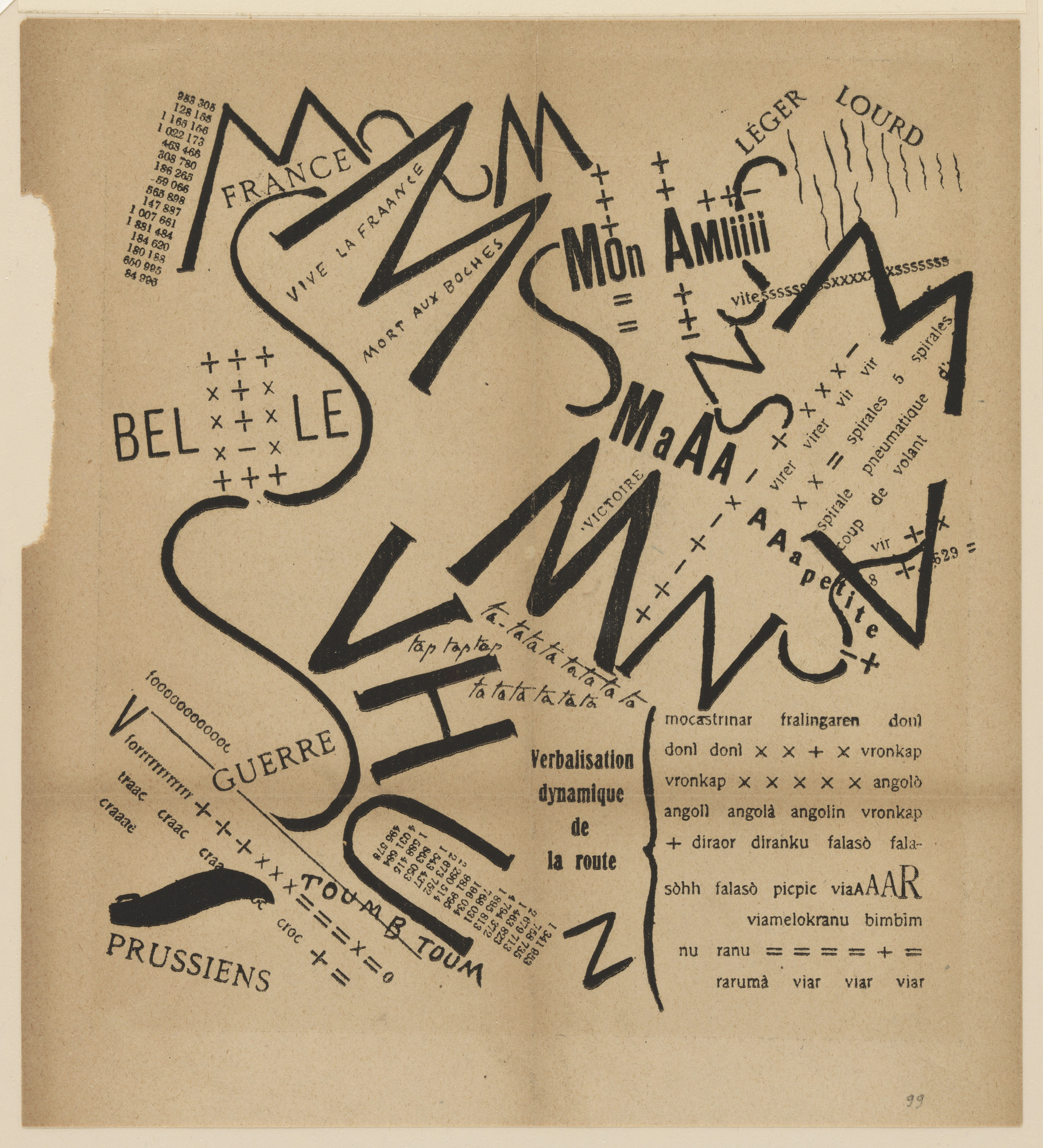
In Marinetti’s 1909 manifesto, Marinetti calls for the reawakening of “divine intuition” that “after hours of relentless toil” allows for the “creative spirit seems suddenly to shake off its shackles and become prey to an incomprehensible spontaneity of conception and execution“.
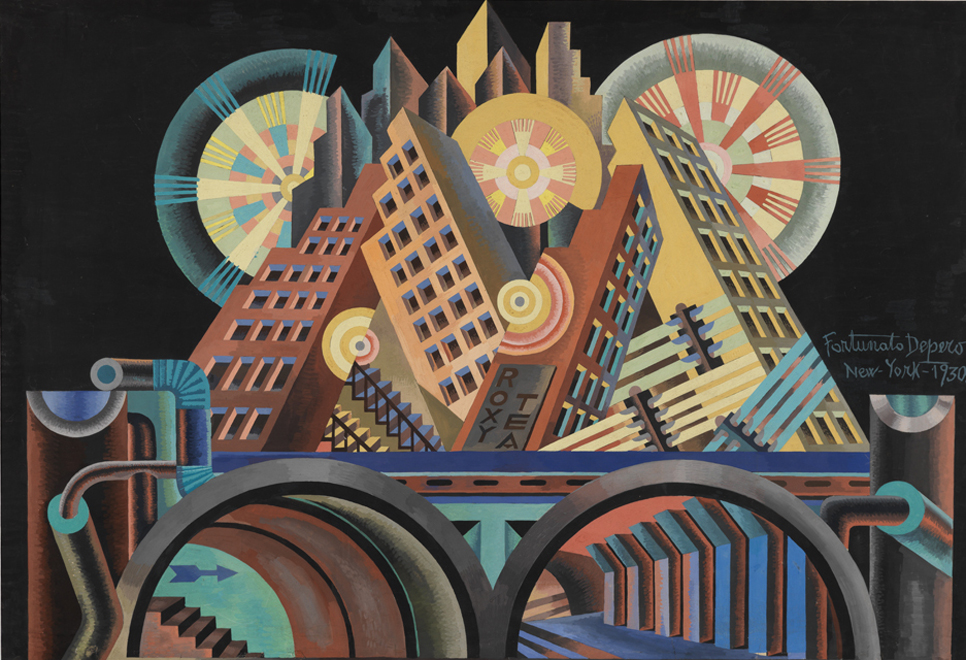
Soffici had a more earthly reasoning.
Intuition was the means by which creation took place.
He believed that there could be no abstraction of the values of futurist literature in logical terms.
Rather, art was a language in and of itself that could only be expressed in that language.
Any attempt to extrapolate from the literature resulted “in the evaluation not of artistic qualities but of extraneous matters”.
As such, the spontaneous creation brought by intuition freed one from abstracting (and therefore adding erroneous material into the literature) and allowed on to speak in the language of art.

In this way, Futurists rallied against “intellectualistic literature and intelligible poetry“.
However, this idea is different from anti-intellectualism.
They were not hostile to intellectual approaches, but just the specific intellectual approach that poetry had taken for so many years.
Therefore, they often rejected any form of tradition as it had been tainted with the previous intellectual approaches of the past.

Analogy’s purpose in Futurist writing was to show that everything related to one another.
They helped to unveil this true reality lying underneath the surface of existence.
That is to say, despite what the experience might show one, everything is in fact interconnected.
The more startling the comparison, the more successful it is.
The means for creating these analogies is intuition.
This intuition is “the poet’s peculiar quality in that it enables him to discover analogies which, hidden to reason, are yet the essentials of art“.
The discovering of analogies is made possible by intuition.

Above: Jodeph Stella, Brooklyn Bridge (1920)
Now, Marinetti believed that analogies have always existed, but earlier poets had not reached out enough to bring appropriately disparate entities together.
By creating a communion of two (or more) seemingly unrelated objects, the poet pierces to the “essence of reality“.
The farther the poet has to reach in terms of logical remoteness is in direct proportion to its efficacy.
As analogy thus plays such an important role, it “offers a touchstone to gauge poetical value: the power to startle.
The artistic criterion derived from analogy is stupefaction“.
While an ordinary person’s vision is colored by convention and tradition, the poet can brush away this top layer to reveal the reality below.
The process of communicating the surprise is art while the “stupefaction” is the reaction to this discovery.
Thus, analogies are the essence of poetry for the Futurists.

As the Futurists advocated the aforementioned intuition and the bucking of tradition, one might assume that they would suppress the use of irony.
On the contrary, irony proved to be “so old and forgotten that it looked almost new when the dust was brushed away from it.
What was new and untried, at least more so than their principles and theories, were the futurists’ stylistic devices”.

Futurists believed that the constraints of syntax were inappropriate to modern life and that it did not truly represent the mind of the poet.
Syntax would act as a filter in which analogies had to be processed and so analogies would lose their characteristic “stupefaction“.
By abolishing syntax, the analogies would become more effective.
The practical realization of this ideal meant that many parts of speech were discarded:
Adjectives were thought to bring nuance in “a universe which is black and white”.
The infinitive provided all the idea of an action one needed without the hindrances of conjugation.
Substantives followed their linked substantives without other words (by the notion of analogy).
Punctuation, moods and tenses also disappeared in order to be consistent with analogy and “stupefaction“.

However, the Futurists were not truly abolishing syntax.
White points out that since:
“The OED (Oxford English Dictionary) defines ‘syntax’ as ‘the arrangement of words in their proper forms’ by which their connection and relation in a sentence are shown“.

The Futurists were not destroying syntax in that sense.
Marinetti in truth advocated a number of “substantial, but nevertheless selective modifications to existing syntax” and that the “Russian Futurists’ idea that they were ‘shaking syntax loose’” is more accurate.

Early Futurist poetry relied on free verse as their poetical vehicle.
However, free verse “was too thoroughly bound up with tradition and too fond of producing stale effects” to be effective.
Furthermore, by using free verse, the Futurist realized they would be working under the rules of syntax and therefore interfering with intuition and inspiration.
In order to break free of the shackles of meter, they resorted to what they called “parole in libertá” (word autonomy).
Essentially, all ideas of meter were rejected and the word became the main unit of concern instead of the meter.
In this way, the Futurists managed to create a new language free of syntax punctuation, and metrics that allowed for free expression.

For example, in the poem entitled “Studio” by Soffici, he “describes the artist’s studio—and by extension, modern man himself—as becoming a ‘radiotelefantastic cabin open to all messages‘, the sense of wonder her being transmitted by the portmanteau neologism: ‘readotelefantastica’“.
Here all notions of familiar language have been abandoned and in their place a new language has emerged with its own vocabulary.
There were four forms of onomatopoeia hat the Futurists advocated: direct, indirect, integral, and abstract.
The first of these four is the usually onomatopoeia seen in typical poetry, e.g. boom, splash, tweet.
They convey the most realistic translation of sound into language.
Indirect onomatopoeia “expressed the subjective responses to external conditions“.
Integral onomatopoeia was “the introduction of any and every sound irrespective of its similarity to significant words“.
This meant that any collection of letters could represent a sound.
The final form of onomatopoeia did not reference external sounds or movements like the aforementioned versions of onomatopoeia.
Rather, they tried to capture the internal motions of the soul.
In order to better provide stark, contrasting analogies, the Futurist literature promoted a kind of hyperconciseness.
It was dubbed essential and synthetic lyricism.
The former refers to a paring down of any and all superfluous objects while the latter expresses an unnatural compactness of the language unseen elsewhere.
This idea explains where poetry became the preferred literary medium of Futurism and why there are no Futurist novels (since novels are neither pared down nor compressed).
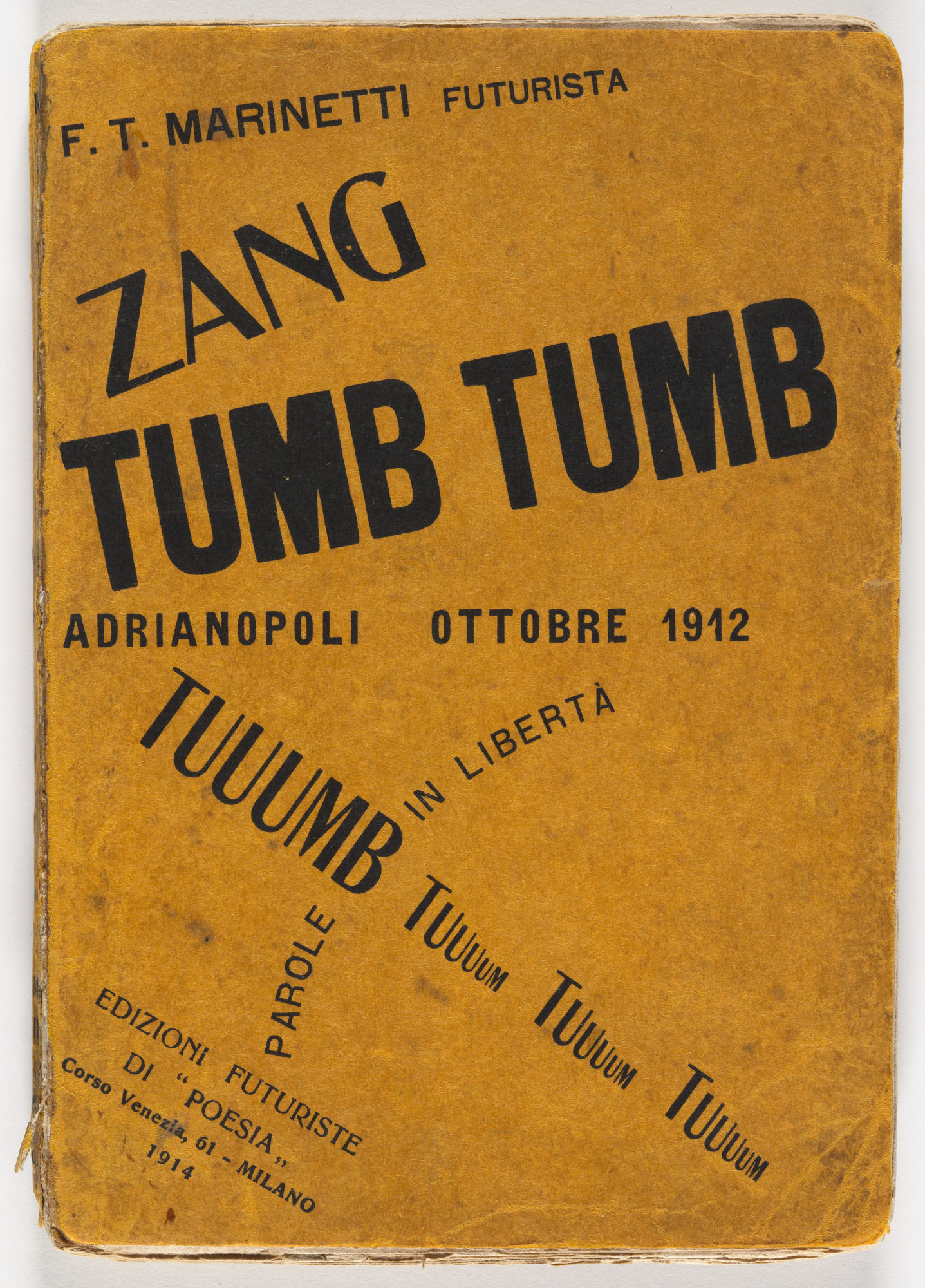
Traditional theatre often served as a target for Futurists because of its deep roots in classical societies.
In its stead, the Futurists exalted the variety theatre, vaudeville and music hall because, they argued, it “had no tradition.
It was a recent discovery“.

Vaudevillian acts aligned themselves well to the notions of “stupefaction” as there was the desire to surprise and excite the audience.
Furthermore, the heavy use of machinery attracted the Futurists, as well as Vaudevillian acts’ tendency to “destroy” the masterpieces of the past through parody and other forms of depreciation.
By adding other Futurist ideals mentioned above, they firmly rooted their beliefs into theatre.
They wanted to blur the line between art and life in order to reach below the surface to reality.
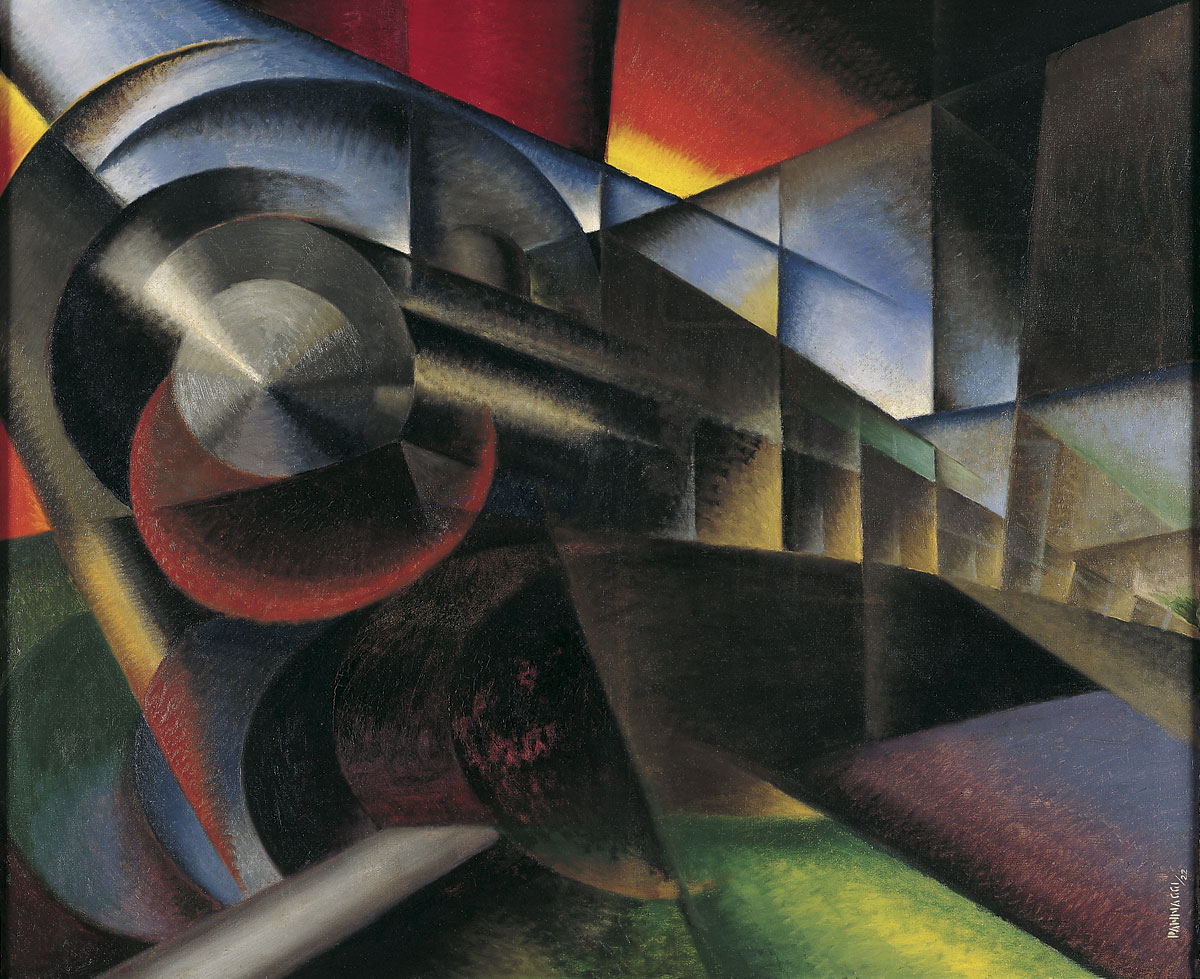
In practice, this manifested itself in various ways:
“Collaboration between the public and the actors was to be developed to the point of indistinction of roles—such cooperating confusion was to be partly impromptu.
For example, chairs were to be covered with glue so that ladies’ gowns would stick to them.
Tickets sold in such a way as to bring side by side men of the extreme right and those of the extreme left, prudes and prostitutes, teachers and pupils.
Sneezing powders, sudden darkening of the hall, and alarm signals were all means to insure the proper functioning of this universal human farce.”
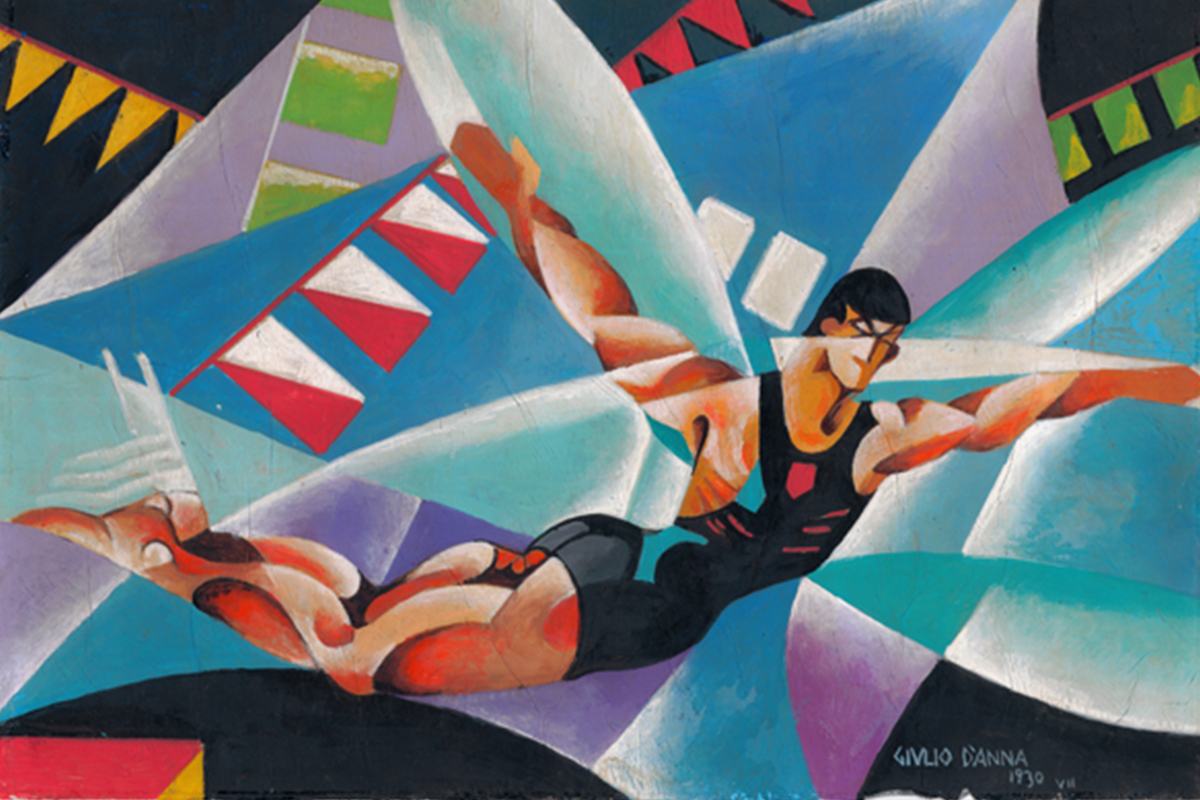
However, the most important aspect of the work was the discrediting of the great works of theatre.
These new theatrical ideal of the Futurists helped to establish a new genre of theatre: the synthetic play.
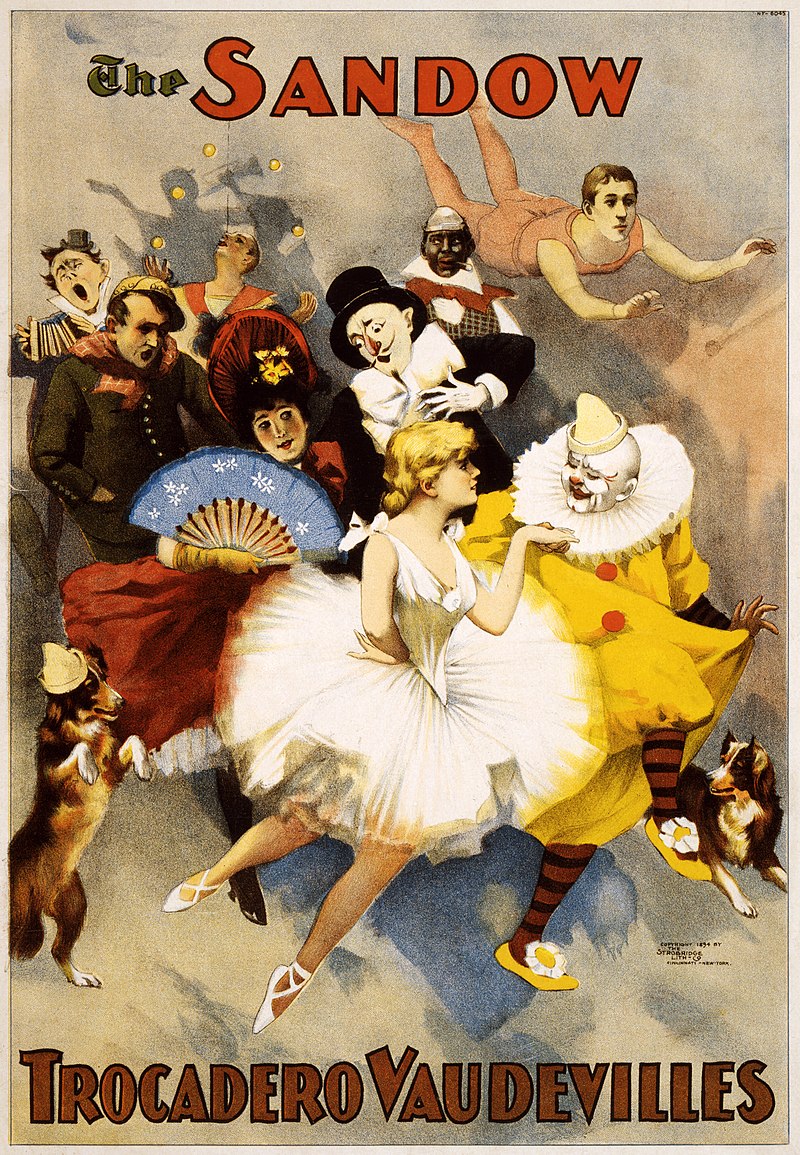
The synthetic play took the idea of compression to an extreme, where “a brief performance in which entire acts were reduced to a few sentences, and scenes to a handful of words.
No sentiments, no psychological development, no atmosphere, no suggestiveness.
Common sense was banished, or rather, replaced by nonsense“.

There did exist some plays similar to this before the Futurists, but they did not conform to the Futurist agenda.
The creator of the first modern synthetic play is thought to be Verlaine, with his aptly titled work Excessive Haste.

Perhaps it was excessive haste that prompted many Italian Futurists to support fascism in the hope of modernizing a country divided between the industrialising north and the rural archaic south.
Like the Fascists, the Futurists were Italian nationalists, radicals, admirers of violence, and were opposed to parliamentary democracy.
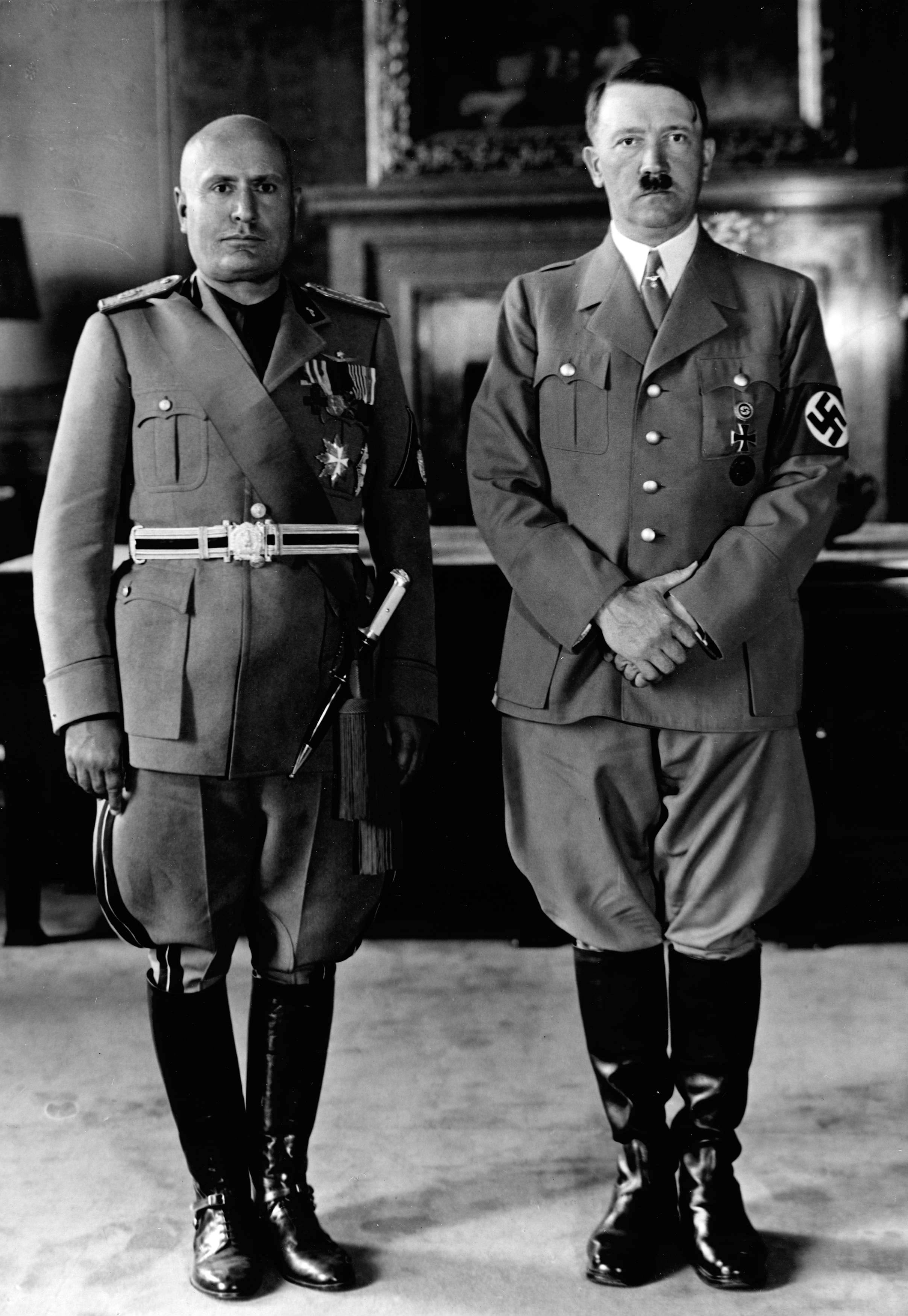
Marinetti founded the Futurist Political Party (Partito Politico Futurista) in early 1918, which was absorbed into Benito Mussolini’s Fasci Italiani di Combattimento in 1919, making Marinetti one of the first members of the National Fascist Party.
He opposed Fascism’s later exaltation of existing institutions, calling them “reactionary“, and walked out of the 1920 Fascist party congress in disgust, withdrawing from politics for three years; but he supported Italian Fascism until his death in 1944.

The Futurists’ association with Fascism after its triumph in 1922 brought them official acceptance in Italy and the ability to carry out important work, especially in architecture.

After the Second World War, many Futurist artists had difficulty in their careers because of their association with a defeated and discredited regime.

Marinetti sought to make Futurism the official state art of Fascist Italy but failed to do so.
Mussolini chose to give patronage to numerous styles and movements in order to keep artists loyal to the regime.
Opening the exhibition of art by the Novecento Italiano group in 1923, he said:
“I declare that it is far from my idea to encourage anything like a state art.
Art belongs to the domain of the individual.
The state has only one duty: not to undermine art, to provide humane conditions for artists, to encourage them from the artistic and national point of view.“
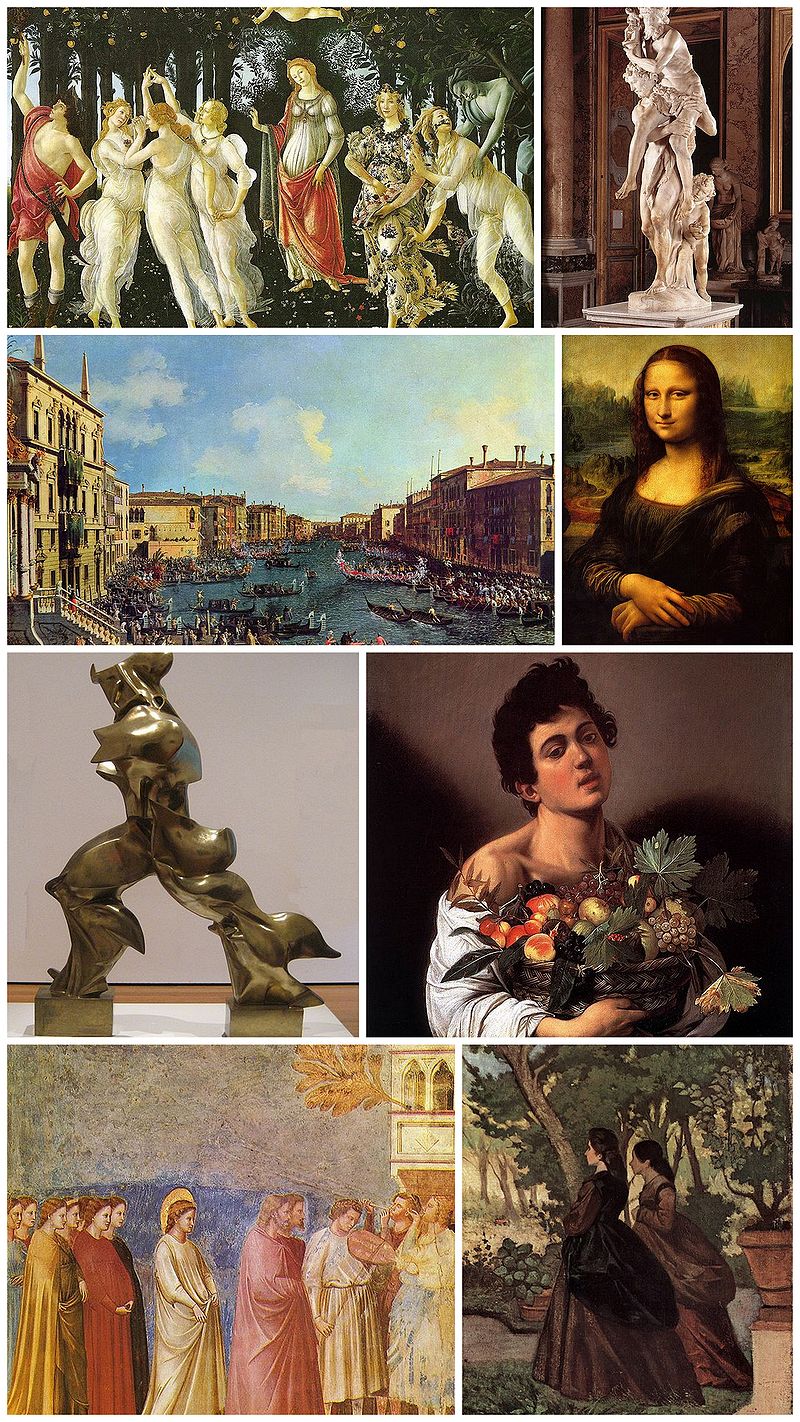
Mussolini’s mistress, Margherita Sarfatti, who was as able a cultural entrepreneur as Marinetti, successfully promoted the rival Novecento group, and even persuaded Marinetti to sit on its board.

Although in the early years of Italian Fascism modern art was tolerated and even embraced, towards the end of the 1930s, right-wing Fascists introduced the concept of “degenerate art” from Germany to Italy and condemned Futurism.

Marinetti made numerous moves to ingratiate himself with the regime, becoming less radical and avant-garde with each.
He moved from Milan to Rome to be nearer the centre of things.
He became an academician despite his condemnation of academies, married despite his condemnation of marriage, promoted religious art after the Lateran Treaty of 1929 and even reconciled himself to the Catholic Church, declaring that Jesus was a Futurist.
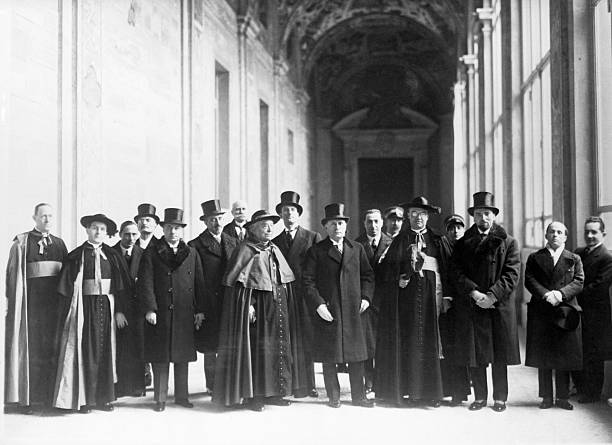
Although Futurism mostly became identified with Fascism, it had leftist and anti-fascist supporters.
They tended to oppose Marinetti’s artistic and political direction of the movement, and in 1924 the socialists, communists and anarchists walked out of the Milan Futurist Congress.
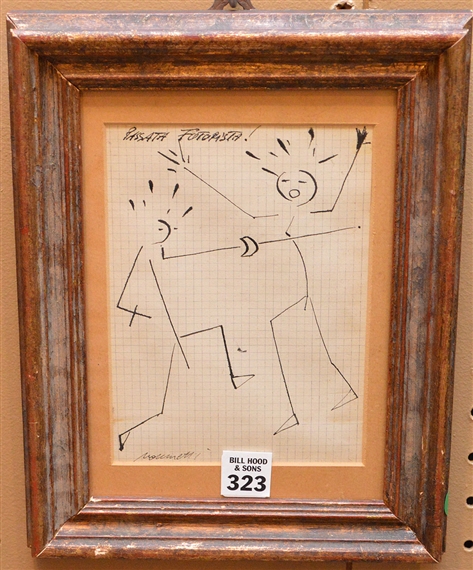
The anti-fascist voices in Futurism were not completely silenced until the annexation of Abyssinia and the Italo-German Pact of Steel in 1939.



This association of fascists, socialists and anarchists in the Futurist movement, which may seem odd today, can be understood in terms of the influence of Georges Sorel, whose ideas about the regenerative effect of political violence had adherents right across the political spectrum.

“We intend to sing the love of danger, the habit of energy and fearlessness.
We will glorify war – the world’s only hygiene – militarism, patriotism, the destructive gesture of freedom-bringers, beautiful ideas worth dying for, and scorn for woman.
We will destroy the museums, the libraries, academies of every kind.
We will fight moralism, feminism, every opportunistic or utilitarian cowardice.
We will sing of great crowds excited by work, by pleasure, and by riot.
We will sing of the multicoloured, polyphonic tides of revolution in the modern capitals.
We will sing of the vibrant nightly fervour of arsenals and shipyards blazing with violent electric moons, greedy railway stations that devour smoke-plumed serpents, factories hung on clouds by the crooked lines of their smoke, bridges that stride the rivers like giant gymnasts – flashing in the sun with a glitter of knives, adventurous steamers that sniff the horizon, deep-chested locomotives whose wheels paw the tracks like the hooves of enormous steel horses bridled by tubing, and the sleek flight of planes whose propellers chatter in the wind like banners and seem to cheer like an enthusiastic crow.”
Filippo Marinetti, The Futurist Manifesto, 1909

Istanbul and Turkey are an ideal setting to examine Marinetti’s notions and the changes they inspired.

On many levels there is much about these ideas to which I must protest.
On many levels there is much about these ideas to which I can relate.
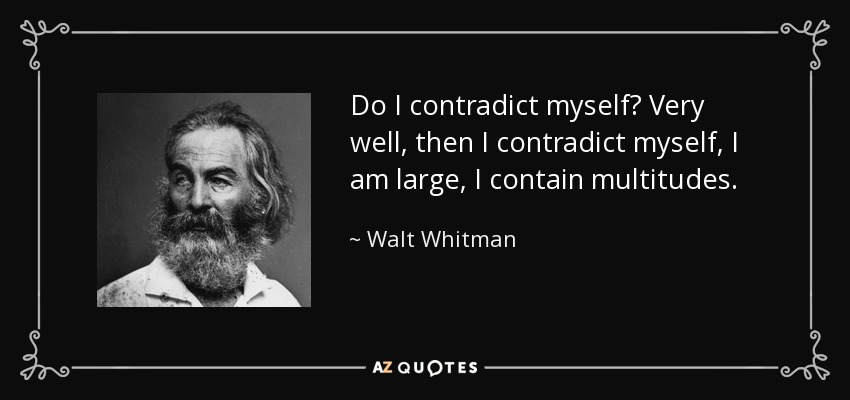
I can relate to the love of danger, for within many a man is the desire to set his inner self free, to cultivate the boy inside the man with youth’s energy and fearlessness.

I cannot and will not glorify war.
War is not the world’s cleanser, but rather its stain and its sorrow.

I reject militarism and feel that soldiers should concern themselves more with service to community rather than naked aggression to nations that affect the infrastructure’s economic interests, a body of individuals less involved in warmongering and war-waging and more involved in peacekeeping.
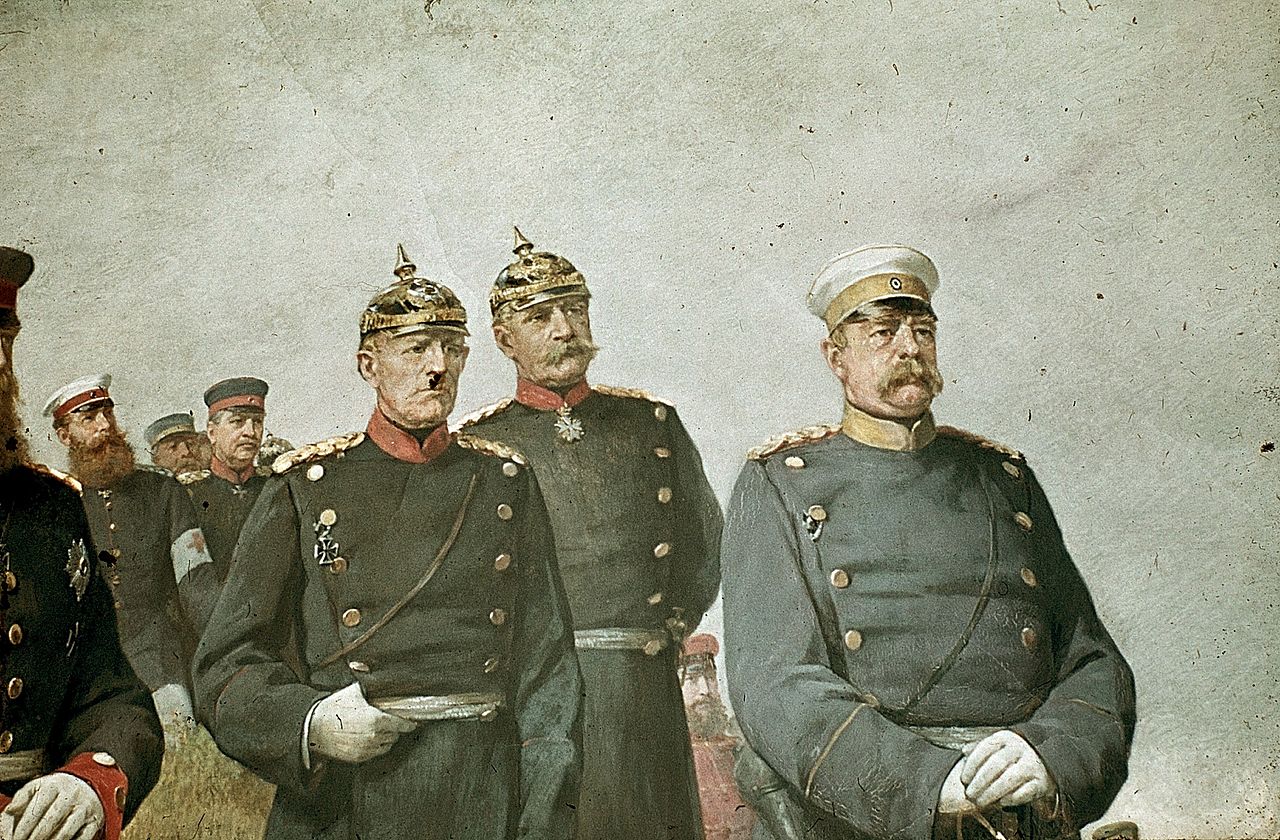
I reject patriotism when it is used to justify immorality and illegality, when it is used as an excuse to justify the evil that men do.

I am all for love of homeland, but home is where all humanity abides, unrestricted by artificial boundaries and enforced borders.

As for the bringers of freedom, it seems to be a sad repetition that one despotic form of rule is merely replaced by another, albeit in a disguised form.
Government is needed for the maintenance of law and order, but let there be no illusion in suggesting that governance resembles freedom for the governed.
Rules and regulations are needed for civilization to function, but not everyone will embrace being ruled and regulated if these restrictions deny them their individuality and freedoms.
Might is not always right.
It is simply stronger.
Fallible men create fallible governance and fallible governance always creates victims.
With time comes change and victims become the victors, but men rarely learn from the errors of the past and what is inevitably becomes an updated version of what was.

There are beautiful ideas worth dying for:
Love, peace, harmony.
Sadly, those who seek power always find the easily-duped followers using these beautiful ideas, corrupting them with notions of nationalism, pride and unity, often manifested as despotism, discrimination and violence.

I can, up to a very limited point, comprehend some scorn for woman, for there are far too many examples of unenlightened vanity within this gender.
But it is my contention that if women enjoyed the same freedom of choices that men enjoy perhaps fewer would follow the vainglorious purveyors of image and would instead seek to be the moral guides of mankind that they could be.
I have often said that there is much to admire about women above and beyond the superficiality of youthful beauty, but there are too many examples of dramatic personas amongst this gender to completely disregard some men’s discomfiture with the feminine sex.

Men need to learn how to interact.
Women need to learn how to be free.
Both genders are a mess.

Where I truly differ with Marinetti is on the question of preservation of the past.
I do not view museums and libraries and academies as the past imprisoning us and keeping us from the potential of the future.
On the contrary, I believe that a study of the past, so as to avoid its errors, is essential in the development of a brighter tomorrow.
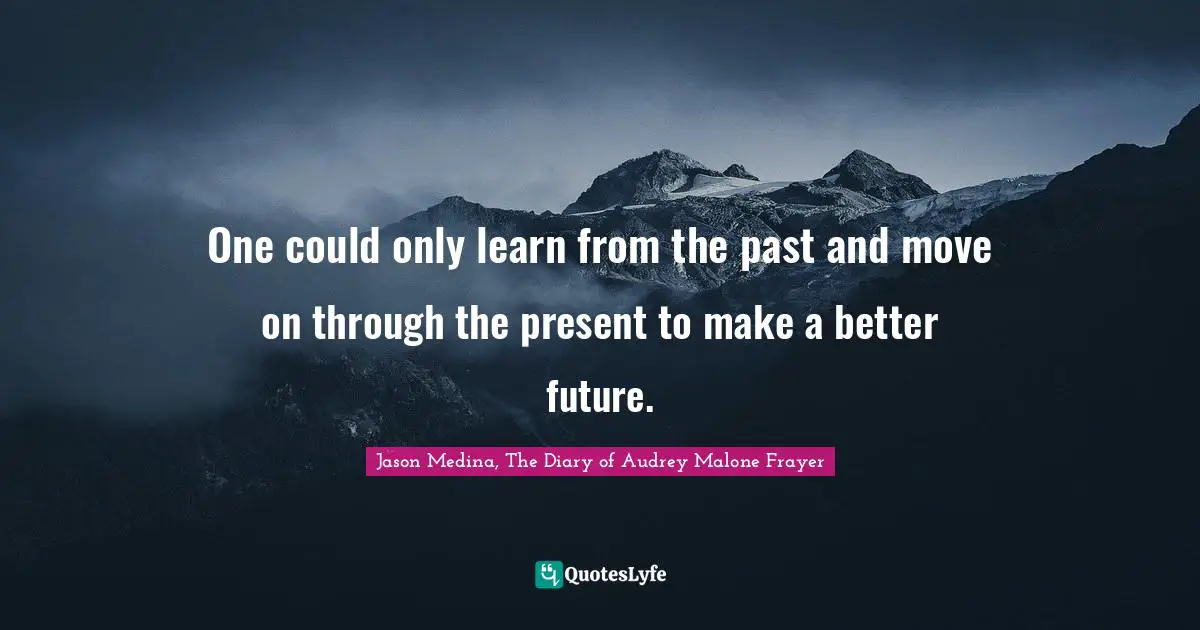
Moralism, a sense of right and wrong, is essential, for without a moral compass we are most assuredly destined for our own destruction.

Feminism is not to be feared, for a liberated woman can truly be an equal to an enlightened man.
Men are the pillars of the earth.
Women are the heavens above.
Without men, the heavens will fall.
Without women, there is no heaven to hope for.

I am not quite sure what Marinetti means by “opportunistic or utilitarian cowardice“, but I assume he means that too many people, rather than seeking solutions to the problems that plague humanity, use every opportunity to enrich and empower themselves instead.

“Things aren’t fine.
We have so many problems, we don’t want to look at them any more.
They just blend together into this great big noise and pretty soon we can’t even hear ourselves think.
But that’s not even the worst part.
The worst part is we feel like we can’t do anything about it.
And that’s a tragedy.
Because we can.
Maybe we don’t know where to start.
Maybe that’s what it is….
You don’t really know how much you can do until you stand up and decide to try.”
Kevin Kline as Dave Kovacs pretending to be President Bill Mitchell, Dave, 1993
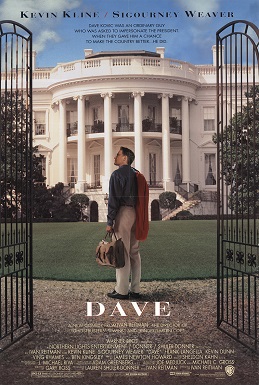
Istanbul and Turkey are great crowds excited by work, excited by pleasure, excited by riot.
If there is a riot in Turkey, rightly or wrongly, it is probably in Istanbul.
If there is pleasure in Turkey, it can probably be found in Istanbul.
If you wish to see hard-working individuals, they can be found in Istanbul.
Turkey was founded by a revolution, is motivated by pleasure, is driven by the energy and effort of its people.

As for “the multicoloured, polyphonic tides“….
Turkey is more than just the Turks.
It is a mosaic of many cultures, many languages, many voices, many peoples.

Regardless of the propaganda and politics of the powers that be in Ankara.
Istanbul is the living embodiment of this mosaic.
Ankara is the resistance to this reality.

Ankara sees arsenals and shipyards and airbases as the source of Turkey’s strength.
They are not.

A nation is its vision of the future, its work in the present, its acknowledgement of both its past successes and its failures.

Turkey is not railway stations, but rather bus stations and autoroutes which far outnumber railroads in this country.
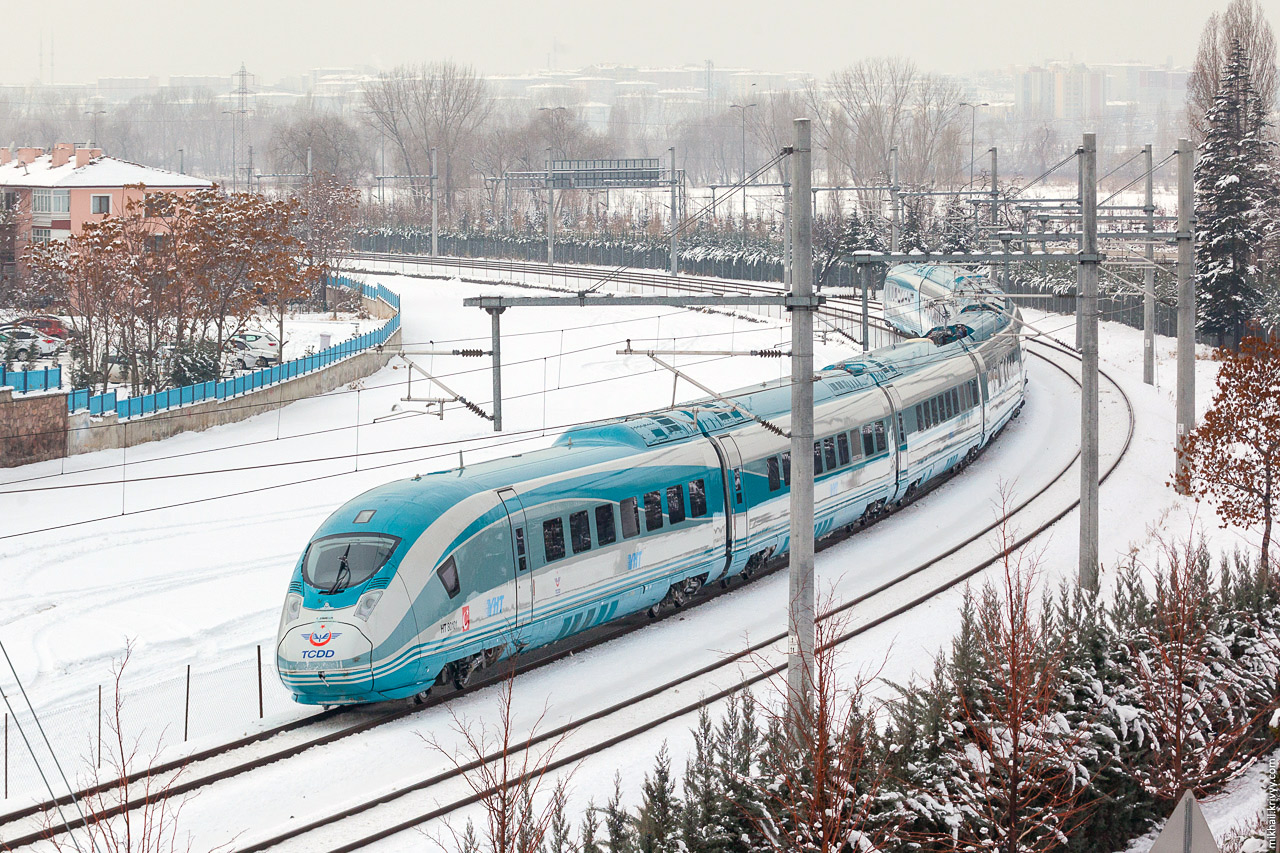


Turkey is its factories, filled with the blood and sweat, tears and toil of its workers.
The sprawl of Istanbul is filled with factories and replete with honourable men and women seeking their fortune in this crossroads of civilizations.
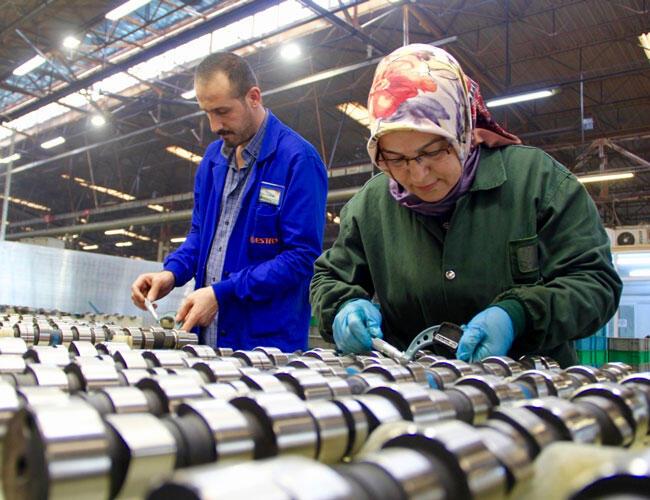
Bridges stride across Istanbul, flashing indeed in the sun like glittering swords piercing the waters and connecting landscapes and continents.

Coaches dart in and out of the city, trams and trains thread criss-cross the metropolis, planes touch the sky suggesting a world beyond Byzantine shores.



I cannot applaud Marinetti’s imagery of enthusiastic crows, for I do not like crows.
They are scavengers, thieves, urban vultures.

On the breakfast terrace of the Tan Hotel, they brazenly fly onto tables, shattering chinaware and stealing what human mouths did not consume or what hotel personnel were lax in removing.
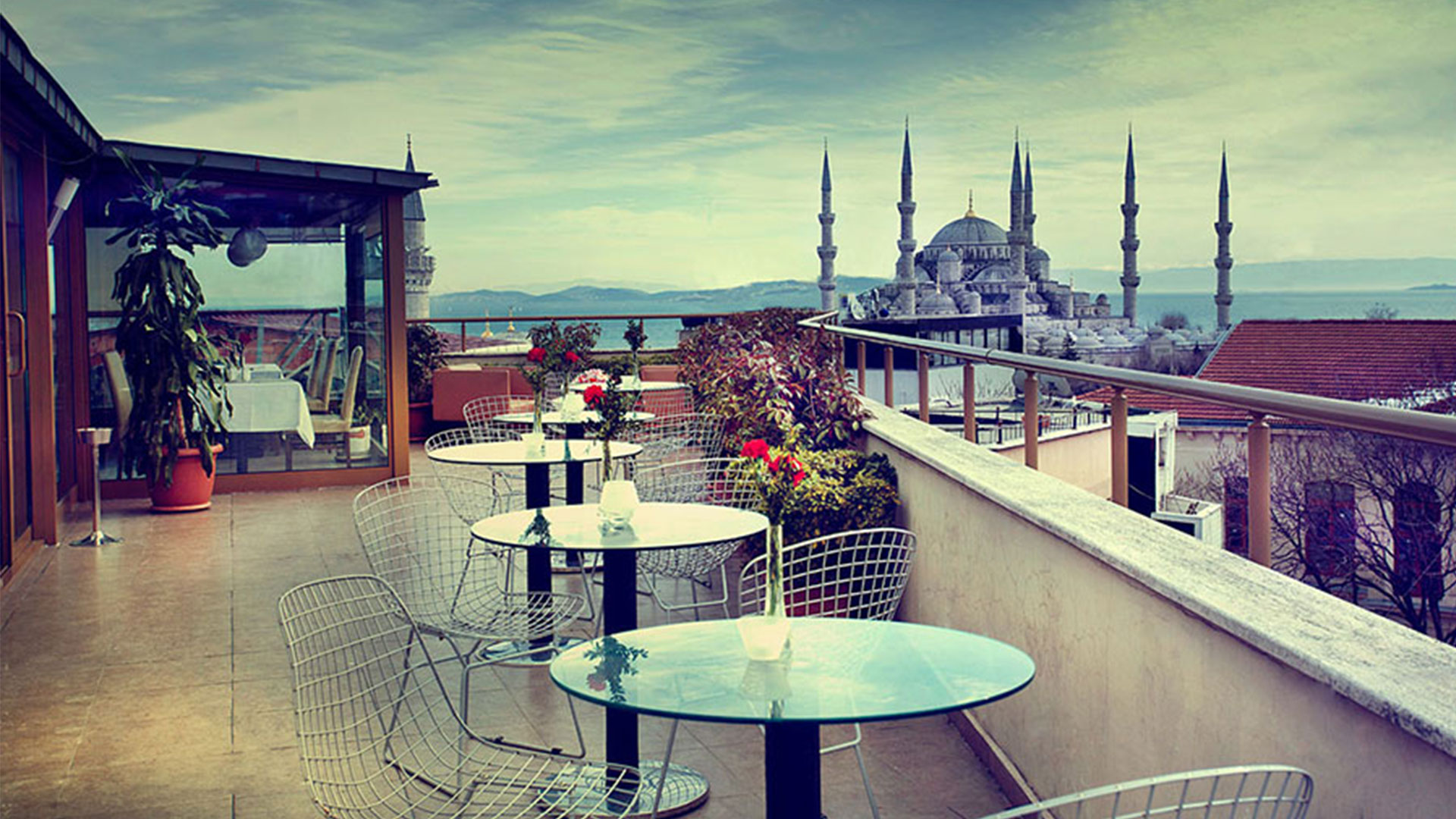
I have no qualms feeding doves or dogs, cats or sparrows, but there is something disturbing about crows, something that haunts the minds of the morbid imagination of writers like Poe or O’Barr.



I wish to see crows nevermore, despite their role in nature’s circle of life.

Sometimes I think that the future of the Futurists is the present, for this is a culture that celebrates speed, modernity and youth, regardless of the consequences of this celebration.
Faster isn’t necessarily better.
It is simply faster.

Modern isn’t necessarily an improvement.
It is merely the inevitability of change.
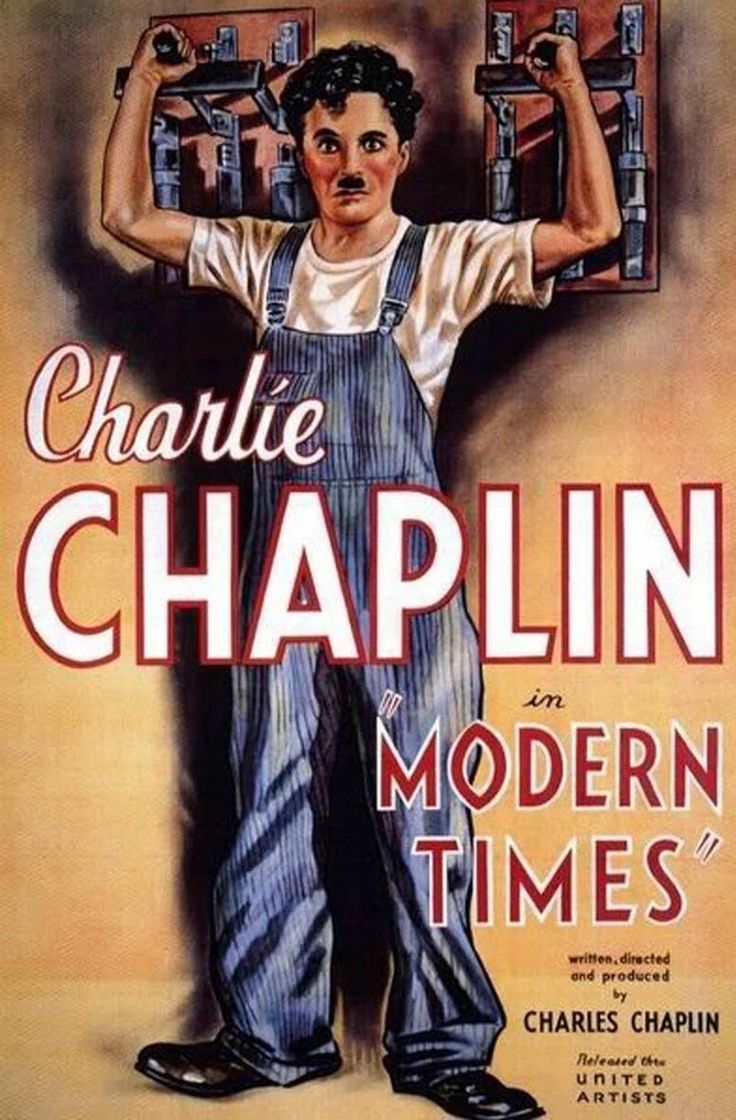
Youth may possess energy and fearlessness, but we should not so easily dismiss the patience and wisdom of age.

Certainly we should embrace new vision, but we should not disregard the value of tradition nor the importance of the past which led us to this moment.
A city is a fast-paced efficient machine, but there is much to be learned from the nature we ignore and destroy at our peril.
Stripping away tradition to reveal the essence of existence is invaluable to our understanding, but we must not forget that traditions first emerged as real solutions to real problems of the age in which they were needed.
The rational has too often been ignored by the emotional elements of the human character, but an incorporation, a balance between the heart and mind is both desirable and necessary for our future survival.

Futurism suggests that we should not maintain something simply because it is traditional, but may I suggest that neither should we destroy something simply because it is old?

Futurism encourages a fusion of man and machine, and it is here that I feel in many ways this vision is evident in our present.
Too much of our lives is dependent upon our technology and I fear the day our technology fails us, for that which is built by fallible man is itself prone to fallible demise.

Futurist literature encourages conciseness and unexpected combinations of images.
This I can, to a point, advocate, especially in these attention-deficient times we live in.
The criticism I receive regarding my writing is that it is lengthy, that it should incorporate more multimedia in its production, but I defend the work that I do by suggesting that some things cannot be expressed succinctly, that a thousand words are better than a picture, for words are the sum of thought while images are often involuntarily expulsions usually no more significant than a burp or a fart in its meaningfulness.

Where I feel futurism fails is in the notion that the past should be forgotten and the focus be on the progress and advancement of one’s nation over others.

But what of the victims of war that futurists glorified?

What of Syria, Yemen and Libya, nations ripped apart by civil strife which is both aided and hindered by international involvement with respect to armaments but a deficiency in humanitarian aid or political compassion for the refugees that war creates?

How easy it is to think of these nations as primitive and backward and less worthy than ourselves of human rights and dignity!
How soon we forget the potential of every newcomer to our land, how alike they are to us in their humanity!

We must not forget the bloodshed and destruction that led people – like ourselves – decent, hard-working folks – to the dire and desperate straits Syrian, Yemeni and Libyan civilians still find themselves in.

Nationalism is killing its people and nationalism is killing our compassion for its victims.
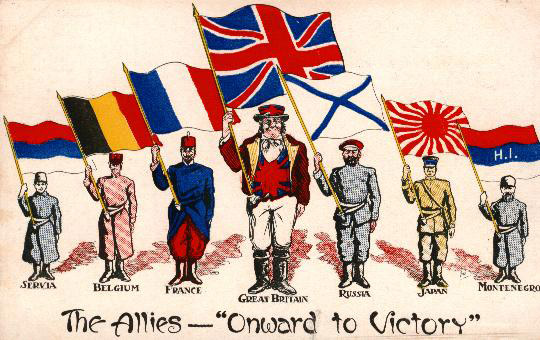
I am so weary of the argument of expenditure that refugees cost their host nations.
I view each newcomer to our nation as an investment in that nation’s future.

“It is one of the ironies of post-war European history that, once the freedom to travel for Europeans living under communist regimes, which had long been demanded by the West, was finally granted in 1989/90, travel was very soon afterwards made much more difficult by the West itself, and new barriers were erected to replace the Iron Curtain.”
Anita Böcker
I am so weary of the argument that our national traditions must be protected from an influx of immigration.
Is a nation so weak that its traditions are so fragile?
Horse hockey!

What about the preservation and demonstration of values that matter?
Faith in the future of a united humanity, compassion for our fellow man, intellectual curiosity about ideas and cultures different than our own?
Are these not worth defending, not worth preserving?

Though there are aspects of futurism evident in our modern times, futurism remains a notion that needs to be rejected for its inhumanity and disrespect towards others and the lessons of the past.

Before I moved from Switzerland, I watched a Swiss movie called Heimatland.
A huge storm is brewing over Switzerland.
The country is in a state of emergency.
The dystopian film is a mixture of a disaster thriller and social analysis.
Heimatland combines tension, entertainment, action and a great story, because it puts Switzerland in a scenario that otherwise only Hollywood dares:
Into the Apocalypse.
The Last Judgement.
Ultimately, this is directed towards those who feel most at home in Switzerland, completely self-righteously.
With the greatest justification at home.

One day dangerous vapors creep out of the crevices of the imposing mountains of Central Switzerland.
The paranormal or simply a climatic catastrophe breaks out.
A huge vortex cloud is gathering in the sky.
It is 1,537 square meters in the morning, nine times larger in the afternoon.

Birds fall dead from the sky, power fails, water runs dry, a little ballet girl becomes scary, a policewoman sees a dead person, a dog runs over the Hardbrücke in Zurich.

All signs point towards doom.
Switzerland’s downfall.

The head of an insurance company goes crazy because he knows that if this cloud runs wild, his company will go bankrupt without government support.
Young Boys fans are even more crazy than usual.
People have to go to air raid shelters, the federal government opens all old redoubts, and the streets soon look like Danny Boyle’s zombie film 28 Days Later.
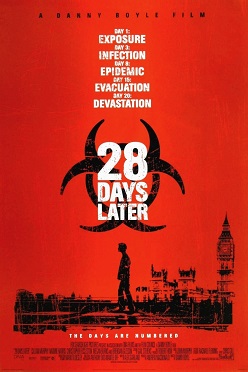
Only a few Utopian party people in Guy Fawkes (1570 – 1606) masks continue to celebrate.

A woman dreams of sex while the cloud is discharging.
There is sharpshooting from central Switzerland, the EU closes the borders.
The full boat Switzerland cannot empty itself.
It can only capsize helplessly.

Above: Location of Switzerland (in green)
Ten directors shot the film Heimatland together.
Their average age is 33.
They have had enough.

“We want to challenge Switzerland with this film.
We don’t want to just sit down with a beer in the evening and talk about what went wrong.
We are part of the problem.”, said Jan Gassmann, one of the ten.
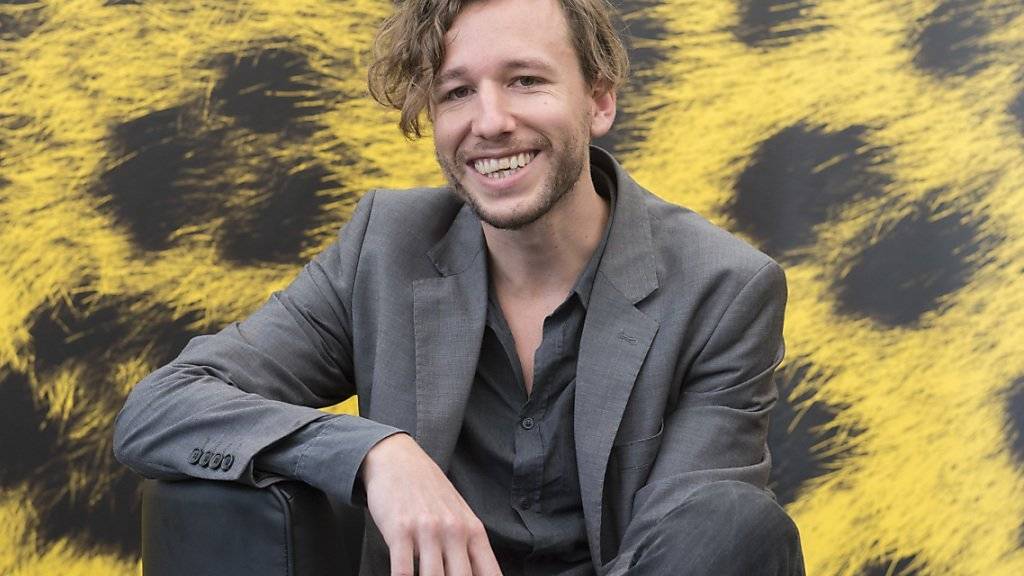
Deliver, not just talk about suffering.
When they started work four years ago, they could not have foreseen many of the coming events.
At that time, the minaret initiative was topical, something like the Yes to the mass immigration initiative of 9 February 2014 was not even conceivable for them.

(The minaret initiative forbids the building of new minarets on Swiss soil.)

(The mass immigration initiative of 9 February 2014 was a referendum that aimed to limit immigration through quotas.
The popular initiative was launched by the nationalist conservative Swiss People’s Party (SVP) and was accepted by a majority of the electorate (50.3%, a difference of 19,526 votes) and a majority of the cantons on 9 February 2014.
This initiative was mostly backed by rural parts (57.6% approvals) of Switzerland as well as by a strong majority (69.2% approvals) in the Italian-speaking canton of Ticino, while metropolitan centres (58.5% rejection) and the French-speaking part (58.5% rejection) of Switzerland rejected it.)
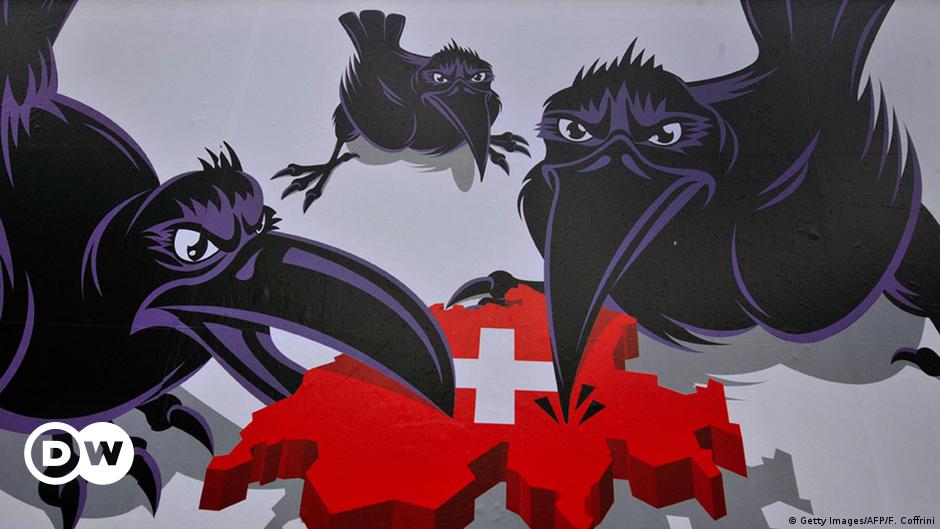
Even then the directors felt that Switzerland was going into a solitary confinement of its own choosing.
And the prescription against it?
The opposite of isolation.
The Community.
Even if it is very often very uncomfortable.

“The Americans,” said co-director Carmen Jaquier, “are very good at showing just one hero who saves everyone.
But that is not the social reality:
There are no individual heroes.
There is only a collective of heroes.
That’s how you have to work today.”

This is how the ten work too.
In terms of content and form.
The fact that these are not ten short films cut together is also thanks to the collective, which also jointly decided to subordinate themselves not only to a story, but also to an aesthetic.
Three cameramen filmed everything.
An editor finally got everything in shape.
Many little darlings fell victim to him, say the directors.
And ten egos.
It was worth it.
In essence, that is the problem with nationalism and that is the problem with futurism:
Pride.
Unjustifiable, unsustainable pride.
Pride is what causes wars.
Pride is what fuels nationalism.
Pride is what makes a rejection of the past seem rational.
But there is no justification in allowing others to suffer or to cause suffering to others.

No nation is innocent of blood on its hands.
Including my homeland where recent discoveries of mass graves of indigenous people have been found in communities in western Canada.

(In May and June 2021, the remains of hundreds of Indigenous people, including hundreds of children, were discovered near the former sites of four Canadian Indian residential schools in the provinces of British Columbia (BC), Saskatchewan (SK) and Manitoba (MB).




The Canada Indian Residential Schools were a network of boarding schools for Indigenous peoples.
Funded by the Department of Indian Affairs branch of the Canadian government, and administered by Christian churches, the school system was created to remove and isolate Indigenous children from the influence of their own culture and assimilate them into the dominant Canadian culture.
Unmarked graves discovered at three of these schools potentially hold the remains of nearly 1,000 previously unaccounted individuals, mostly children.)

Clearly, today, we have much to learn from the past, about the wisdom of compassion.
But politicians are too aware of the song “of the multicoloured, polyphonic tides of revolution in the modern capitals“, that cry for change that respects the dignity of individuals in society over the thirst for power of those who seek to dominate others for their own profit and glory.
The quiet change, the nonviolent revolution, the commitment of compassion, should have happened a long time ago.
Maybe tomorrow.

Sources: Wikipedia / Google / Hürriyet Daily News, 25 June 2021